Archive for the ‘Wildness’ Category
Thursday, December 22nd, 2011
This article was initially published by Tigerquoll on Candobetter.net on 20090625 under the title ‘Shooters Party – fanatical red necks pushing for open season in National Parks’.
.
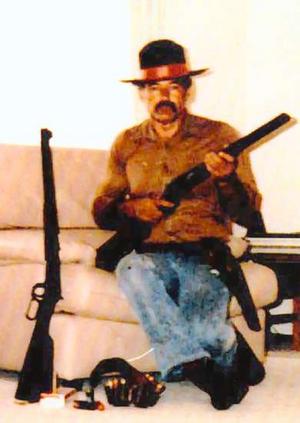 An infamous licensed shooter
An infamous licensed shooter
.
Since May 2009, Robert Brown MP of the Shooters Party has been pushing for the Game and Feral Animal Control Amendment Bill 2009 to be passed into legislation in New South Wales, Australia. The spin of this Bill is so feral animals can be controlled in National Parks. But in reality the proposed changes would mean the following main changes:
.
- Many of Australia’s native fauna across NSW would be condemned as ‘game animals’ just like in colonial times, when Australian native animals were despised as ‘vermin’. Other native animals can be included in the shooters hit list so long as there is consultation with the Minister for National Parks (DECC).
- It would be lawful for sporting shooters to hunt and shoot native fauna in all National Parks, State Forests, Crown Land and ‘private game reserves’ across NSW. Killing wildlife is to be branded as ‘conservation hunting’ and basically would be permissible through most natural landscapes outside built up areas.
- The Game Council of NSW, which is a government body dominated by members of shooting and hunting clubs, and it would assume authority for granting shooting licences in National Parks.
- Shooters and hunters in National Parks would be immune from protesters trying to protect native animals and birds – as it would become “an offence to approach persons (within 10 metres) who are lawfully hunting on declared public hunting land, or to interfere with persons lawfully hunting game animals”.
- Any environmental protection legislation that impedes shooting and hunting of native animals is to be overriden by the new changes – such as under the National Parks and Wildlife Act 1974.
- Hunting of native game animals can be done by non-commercial shooters – i.e weekend sports shooters. Using spot lights is optional and it is ok to leave the dead, dying and injured prey where they fall.
- In the case of native waterfowl, licensed game hunters will be required to pass an official identification test of native waterfowl. The record of shooters killing protected bird species is woeful, yet the proposed legislation won’t make any difference.
.
(Source: New South Wales Legislative Council, Game and Feral Animal Control Amendment Bill 2009, Second Reading in Parliament)
.
Professional safari hunters, recreational hunters, sports shooters, or weekend warriors?
.
This Bill would overturn all environmental legislation protecting our remaining wildlife in NSW. It is repugnant. This proposal is nothing to do with noble gesture of taking on the task of the government’s culling feral animals in National Parks.
.
The Game Council in this self-interested set of demands, simply wants to give its weekend warrior member base open slather access to shoot almost anything and everything in the bush. It would be 24/7 open season on wildlife perpetually across NSW every day of the year. Every weekend would be weekend warrior party time in the ute with the spotties and the beers and the guns – just like in the good old days eh? In doing so, The Game Council and the Shooters Party have shown their true colours. The Game Council’s objective is to provide for the effective management of ‘introduced species’ of game animals. By advocating the hunting and shooting of native animals and birds is outside its ‘introduced species’ charter.
.
According to Greens MP Ian Cohen, if feral animals are to be culled then:
“it should be managed by trained Livestock Health and Protection Authority officers.” “Recreational hunters are not helping when it comes to feral species – the reality is that hunters, with their dogs, are often a cause of pest species dispersal, driving feral animals into national parks.”
.
Fortunately, NSW Cabinet yesterday backed away from supporting the Bill.
‘Ivan Milat was a licensed competition shooter. In police interviews he referred to a shooting range in the Belangalo State Forest he knew well.‘
.
(Source: ^http://www.abc.net.au/austory/content/2004/s1239470.htm)
.
Milat was probably a member of a local shooting club, perhaps the Bowral Pistol Club situated in the Belangalo State Forest or with the Southern Highlands Rifle Club. As such, Milat would have been eligible to have been one of the licensed shooters/hunters under this Bill before being convicted of his crimes. This example of a licensed competition shooter does not engender public confidence in the shooting and hunting fraternity to be trusted to self-regulate itself and attract law abiding citizens and carte blache access to National Parks for shooting!
Message:
Exclude all native animals as ‘game’ and prohibit the use of dogs in all hunting and shooting and you will have me starting to listen to proposals by The Shooters Party to control feral animals. But as for controlling feral animals in National Parks in NSW, this is an ecological management matter for DECC to be held accountable for.
To be genuine about feral control, this Bill must specifically exclude:
- Native animals
- National Parks
- Recreational shooters
.
The intent then of The Shooters Party to help control ferals will starts becoming more genuine.
- If the Bill is one of targeting ferals, why does it include native animals in National Parks?
- If the Bill is one of targeting ferals, why is it limited to shooting and not other control means?
- Why are the government authorities most qualified to control feral animals not granted the delegated responsibility for this Bill?
- Where in this Bill does it specify controls on the time of day that shooting can take place? (i.e. it is 24/7)
- Where in this Bill does it specify how shooting is to be independently policed? It doesn’t.
- Where in this Bill does it specify that only qualified marksman trained in species identification will be permitted to engage in feral hunting in national parks? Why are recreational hunters permitted without the high standards of marksmanship and species recognition training?
- Where in the Bill are inexperienced recreational hunters prohibited from such shooting? These are the ‘weekend warriors’ that give the contract professionals a bad name, yet the The Game Council is not going out of its way to distinguish these two extremes.
- Who will be monitor, police and breath test the shooters?
- Who will watchdog those monitoring the shooters to ensure that all legal, environmental and ethical standards are properly complied with?
.
Under The (NSW) Fireams Act 1996 Part 2, Division 1, Clause 10 ‘Applications for Licences, all that is required to be granted a firearms licence is:
- Be over 18
- Show proof of ID
- Be someone who has not been convicted of an offence within the past 10 years
- Not subject to an apprehended violence order
- Not subject to a good behaviour bond
- Not deemed not a risk to public safety
- Pay the license fee.
.
Convicted backbacker murderer, Ivan Milat, was a legally licenced shooter and got through these stringent ‘elite’ tests and he owned multiple longarm firearms.
How does this reflect upon the test standards for firearm owners?
Since 18 August 2008, the Firearms Amendment Act 2008 has required unlicenced persons seeking a licence for longarms undertake and pass an approved Firearms Safety Qualification (Long-arms) Course. This is admittedly a step in the right direction.
.
(Source: NSW Shooting Centre)
.
Lack of professional controls for shooters
.
Under Firearms Regulation 2006 (NSW) clause 28 ‘Recreational hunting/vermin control—persons who are not members of approved hunting clubs’, an applicant can obtain a firearm licence without being a member of an approved hunting club in order to engage in recreational hunting/vermin control so long as they obtain and hold written proof of permission to shoot on rural land by the landholder which must describe the land to which the permission relates and the type of game to be shot.
But there is nothing in the legislation to enable a firearm holder to have a licence suspended or revoked as a result of shooting protected wildlife.
The NSW Department of Environment and Conservation, not the Game Council should be the prescribed authority for all vertebrate pest animal control.
.
Poor Species identification training
.
It is quite obvious that a feral animal is not synonymous with a native animal. One would hope that a shooter can distinguish a rabbit from a wombat, but what training exists to ensure natives are not mistakenly shot. Where is the policing to ensure that natives are not shot intentionally?
.
‘Conservation Hunters’?
.
Surely, this conjured term is oxymoronic spin. Instead, the designation ‘professional contract shooter‘ needs to be distinguished from ‘recreational shooter‘. If this Bill is to genuinely seek a professional approach to feral animal control it must specifically exclude recreational shooters and the weekend warrior element.
.
‘Ancestral & cultural right to hunt’?
.
The loose premise of some “ancestral & cultural right to hunt” – may apply to traditional Aborigines using traditional methods on traditional lands away from populated areas, but to quote the Game Council’s NSW Hunter eduication Handbook.. “in today’s world, hunting is no longer a necessity for most of us, but is something we are never the less driven to the associations with our past.” (p4.1.5). So this rather dubious argument says hunting is justified by some nostalgic notion of being connected to early colonists.
Airguns to teens are a catalysts for psychopaths. The book ‘Sins of the Brother: The Definitive Story of Ivan Milat and the Backpacker Murders‘ is an eye opener into a case of a hard rural lifestyle controlled by hardline paternal corporal punishment, when guns are part of life and temper tolerated.
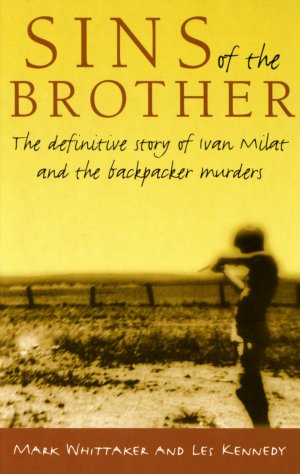 Publisher: ^http://www.panmacmillan.com.au/ Publisher: ^http://www.panmacmillan.com.au/
.
“Guns are power” as confirmed by Ivan Milat’s brother Boris. Untempered power leads to consequences only limited to the discretion of the person in control.
Gun laws in Australia fuel criminal opportunity, yet gun laws don’t test for criminality. A cocktail of a gun acceptance culture, killing of animals from an early age, an insular rural upbringing, a penchant for control, an uncontrolled aggression, and opportunity are a recipe for incubating deviancy and how Ivan Milats and Martin Bryants are made. Milat’s upbringing featured a tolerance of incest, which fueled sexual depravity.
.
It starts with children being given airguns (or similar). Airguns inculcate shooting living things as acceptable.
.
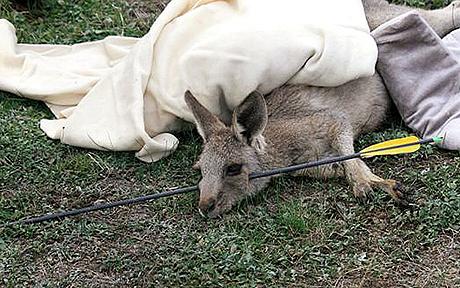 Kangaroo survives arrow shot through head Kangaroo survives arrow shot through head
Melbourne (2009):
‘A kangaroo survived for about a week after being shot through the head with an arrow, wildlife officials said, and is expected to make a full recovery. Wildlife Australia has posted a A$10,000 dollar (£5,032) reward to find the person responsible for shooting the kangaroo, which was found in parkland near Melbourne’s outer suburbs on Thursday.
Veterinary surgeons from Melbourne Zoo operated on the stricken animal over the weekend and were optimistic about his chances.
“This was a big injury, but because the arrow didn’t seem to have been in there for a long time, and the injury was fresh, hopefully he’ll be okay,” said Michael Lynch, a vet at Melbourne Zoo.
“I’m cautiously optimistic about the kangaroo’s prospects for a full recovery.”
The marsupial was rescued just days after another kangaroo was found with an arrow in its rump in the same location, said Fiona Corke, a Wildlife Victoria spokesman. She said her organisation wanted to catch those responsible.
“It’s just unbelievable, I just can’t believe that anybody would do something so cruel. It must be a very cold-hearted person to do that,” she told national news agency AAP.
Miss Corke said the kangaroo was believed to have survived for up to a week before it was discovered and taken to an animal hospital.
.
(Source: ‘Kangaroo survives arrow shot through head‘, Telegraph (UK), 20090511, ^http://www.telegraph.co.uk/news/worldnews/australiaandthepacific/australia/5309242/Kangaroo-survives-arrow-shot-through-head.html)
Tags: air gun, air rifle, animal cruelty, bb gun, hillbilly, Ivan Milat, kangaroo poaching, Martin Bryant, pellet gun, Shooters Party, slug gun, Wildlife
Posted in Kangaroos and Macropods, Threats from Poaching and Poisoning | 1 Comment »
Add this post to Del.icio.us - Digg
Wednesday, December 14th, 2011
Chinese-owned Yancoal’s Austar Coal Mine in the Hunter Valley, yesterday was found guilty by the Land and Environment Court in New South Wales of gross pollution of Bellbird Creek near Cessnock back in July 2010. Wastewater from the mine’s antiquated on-site septic system was allowed to seep into the creek, killing aquatic wildlife. But it has taken a year and a half for the court to finally prosecute the offence brought before it by the Environmental Protection Agency (EPA). Why?
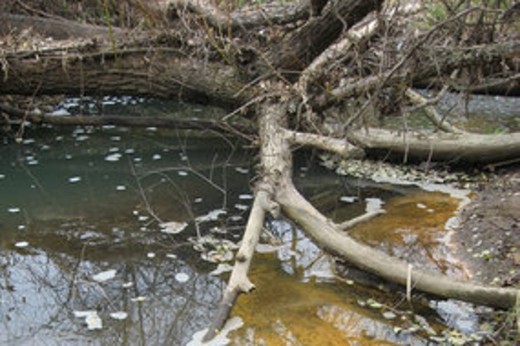 Septic pollution of Bellbird Creek
near Cessnock, Hunter Valley, New South Wales, Australia Septic pollution of Bellbird Creek
near Cessnock, Hunter Valley, New South Wales, Australia
.
Yancoal Australia’s parent company is Chinese-based Yanzhou Coal Mining Company, which is ultimately owned by the Shandong provincial government of China. Yanzhou promotes itself as being one of the safest and most productive users of Longwall Top Coal Caving technology (LTCC). Visit its website: ^http://www.yancoalaustralia.com.au/key-assets/austar-coal-mine/
Under its ‘Community Awareness’ section, subsidiary Yancoal Australia offers a scholarship program to assist undergraduate students choosing to pursue a career in the mining industry. How is this community awareness? Obviously there is a lack of environmental awareness. Mining profits are going back to China, at the Hunter Valley’s expense and at Bellbird’s expense.

The logo is very clear about the source and the impact
.
The court has fined Austar $115,000 for the pollution, including ordering Austar Coal Mine to pay $75,000 towards an environmental rehabilitation project and $42,000 in the EPA’s legal costs. This will be on top of Austar’s own legal costs. Austar has also been ordered to publish details of the offence in a local newspaper and industry magazine.
Chief Environmental Regulator for the Environment Protection Authority (EPA), Mark Gifford said “The wastewater contained detergent and effluent from bathhouse facilities located on the Austar site and caused large clumps of white foam up to 2 metres high to be washed downstream.
“The elevated levels of detergent, nutrients and faecal matter along approximately 2km of Bellbird Creek were toxic to aquatic life,” Mr Gifford said.
“This incident could have been prevented if Austar had an appropriate system in place to inspect, monitor and maintain the 90 year old onsite septic system.”
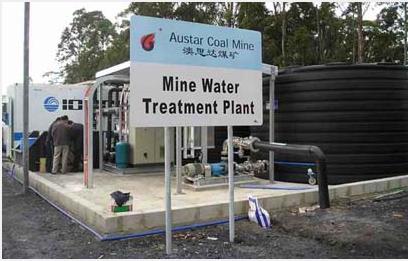
EPA Regional Manager Graham Clarke says it was not a minor incident.
“These are very large scale facilities, obviously bathhouse for the mine facilities they’re not just domestic systems and clearly large amounts of detergent and pollutants were coming from the system into the Bellbird Creek,” he said. “So it’s affected about two kilometres of the waterway at the time so these are not small incidents.”
.
But something is clearly amiss. For Austar’s mine pollution of detergent, nutrients and faecal matter to ‘extend two kilometres downstream‘ along Bellbird Creek and for ‘large clumps of white foam up to 2 metres high‘, this was not ‘seepage‘ – more like full-throttle pumping! Downstream also involves flowing through the village of Bellbird, effectively creating an open sewer through Bellbird.
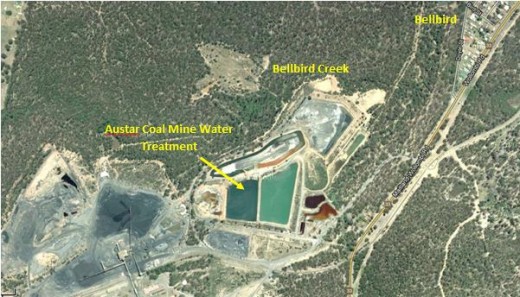
Following NSW Labor Government approval for Austar Coal Mine to begin longwall mining on its Hunter Valley lease, the company published its Community Information Sheet 4 dated June 2006, which on page 2 states:
‘Upgrades to the water management system to improve the recycling of mine water. Austar has been working closely with the Department of Environment and Conservation (EPA) to optimize water recycling and reduce dependency on external water supplies. The proposed improvements will include upgraded pumps, pipelines and water treatment facilities resulting in the Austar mine being almost self-sufficient in water supplies.’
.
The EPA has clearly been negligent in its monitoring, but then the EPA has no watchdog. To fine Yancoal $115,000 is a mere slap on the wrist. Yancoal recorded $1 billion in revenue in 2010, and sold 11 million tonnes of coal from its five operating mines on the east coast. So Yancoal has been fined 0.0115% of its annual revenue – petty cash! [Source: ‘Wesfarmers agrees to $300m Premier Coal deal with Yancoal’, by Nick Evans, Business Reporter, PerthNow, 20110928, ^http://www.perthnow.com.au/business/local-business/wesfarmers-agrees-to-300m-premier-coal-deal-with-yancoal/story-e6frg2s3-1226148929703]
.
- Where is the EPA’s Environmental Impact Statement made available to the local community?
- What has been the ecological cost?
- Where have the pollutants ended up?
- What is the risk to public health of Bellbird and downstream communities?
- What is the full cost of clean up to restore Bellbird Creek and its affected downstream waterways to a before pollution condition and to reinstate the ecological health of the waterways?
- Given Yancoal holds significant coal assets in Queensland and New South Wales, what monitoring is the EPA in those states doing, given that Yancoal has demonstrated that it cannot be trusted to protect the environment?
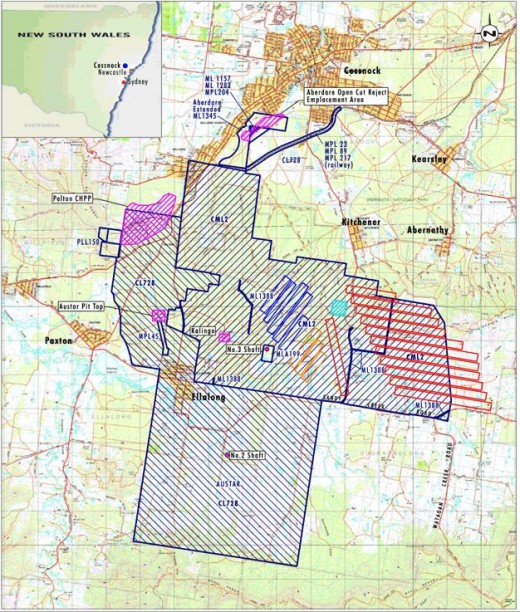 Yancoal’s Mining Leases in the Hunter Valley – set for underground long wall mining Yancoal’s Mining Leases in the Hunter Valley – set for underground long wall mining
.
[Sources: ‘Hunter Valley mine fined for polluting creek’, ABC, 20111213, ^http://www.abc.net.au/news/2011-12-13/hunter-valley-mine-fined-for-polluting-creek/3729336/?site=newcastle, ^http://www.environment.nsw.gov.au/media/DecMedia11121301.htm, http://www.abc.net.au/news/2011-12-14/mine-fine-for-polluting-creek/3729942]
.
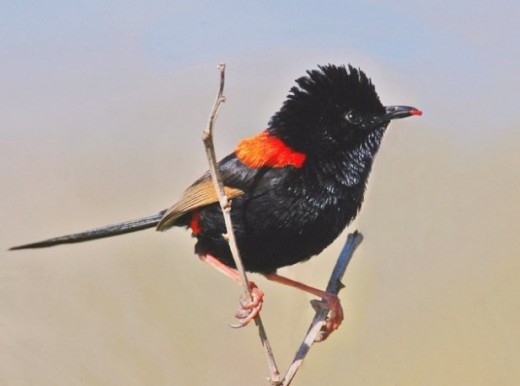 Red-backed Fairy-wren of the rivers of the Hunter Valley
. Red-backed Fairy-wren of the rivers of the Hunter Valley
.
The Red-backed Fairy-wren (Malurus melanocephalus) is a passerine bird in the Maluridae family. It is found only in Australia along the coasts of rivers. These rivers are the Hunter Valley in New South Wales and the Kimberley which is the northern portion of Western Australia.
[Source: ^ http://www.redorbit.com/education/reference_library/science_1/birds/2582912/redbacked_fairywren/index.html]
.
Tags: aquatic habitat, Austar Coal Mine, Austar fined, Bellbird Creek, detergent, EPA, Hunter Valley Coal Mining, Longwall Top Coal Caving (LTCC), mining pollution, nutrients and faecal matter, Red-backed Fairy-wren, septic system, Yancoal Australia, Yanzhou Coal Mining Company
Posted in Birds (Australian), Threats from Mining | No Comments »
Add this post to Del.icio.us - Digg
Saturday, December 3rd, 2011
This article was initially published by Tigerquoll 20090622 onCanDoBetter.net under the article title ‘Rees’ ‘red hot go’ hunting in our National Parks‘. It has been modified somewhat.
.
New South Wales Premier Rees is set to pass into law a ‘Game and Feral Animal Control Amendment Bill 2009‘ to permit recreational hunters shooting everything and anything in protected National Parks across NSW, including native wildlife.
Controlling feral animals is a science, not a sport. Rees’ passion for sport is compromised by influential cronies and naivety. Problem is: Rees has no knowledge, experience in or aptitude for science. His inaugural “red hot go” says it all and threatens to be his legacy.
 Australian Wood Duck (Chenonetta jubata) Australian Wood Duck (Chenonetta jubata)
(a native species not protected)
©Photo by Ákos Lumnitzer (with permission), ^http://www.amatteroflight.com/
.
Be clear, the Game and Feral Animal Control Amendment Bill 2009, Schedule 3, Part 2 lists the following Australian native fauna as free ‘game‘, including:
.
Native Ducks:
Australian Shelduck (or Mountain Duck) (Tadorna tadornoides)
Australian Wood Duck (or Maned Duck) (Chenonetta jubata)
Black Duck (or Pacific Black Duck) (Anas superciliosa)
Blue-winged Shoveler (or Australasian Shoveler) (Anas rhynchotis)
Chestnut Teal (Anas castanea)
Grass Duck (or Plumed Whistling Duck) (Dendrocygna eytoni)
Grey Teal (Anas gibberifrons)
Hardhead Duck (or White-eyed Duck) (Aythya australia)
Pink-eared Duck (Malacorhynchus membranaceus)
Water Whistling Duck (or Wandering Whistling Duck, Whistling or Wandering Tree Duck) (Dendrocygna arcuata)
Native Quails:
Brown Quail (Coturnix ypsilophora)
Stubble Quail (Coturnix pectoralis)
Native Birds:
Australian White Ibis (Threskiornis molucca)
Black Swan (Cygnus atratus)
Common Bronzewing Pigeon (Phaps chalcoptera)
Galah (Eolophus roseicapilla)
Little Corella (Cacatua sanguinea)
Long-billed Corella (Cacatua tenuirostris)
Purple Swamphen (Porphyrio porphyrio)
Straw Necked Ibis (Threskiornis spinicollis)
Sulphur Crested Cockatoo (Cacatua galerita)
Topknot Pigeon (Lopholaimus antarcticus)
Kangaroos:
Eastern Grey Kangaroo (Macropus giganteus)
Euro (Macropus robustus)
Red Kangaroo (Macropus rufus)
Western Grey Kangaroo (Macropus fuliginosus)
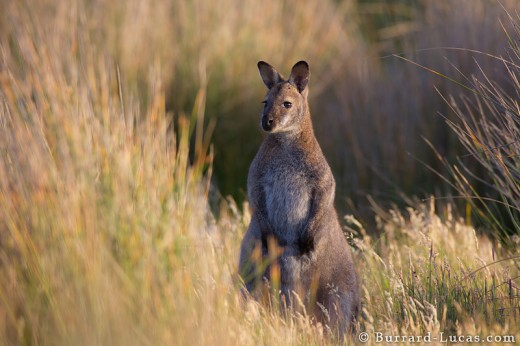 Bennetts Wallaby (Red-Necked Wallaby) (Macropus rufogriseus)
is native to Tasmania, but is not protected
(© Photo Burrard-Lucas) ^http://www.burrard-lucas.com/ Bennetts Wallaby (Red-Necked Wallaby) (Macropus rufogriseus)
is native to Tasmania, but is not protected
(© Photo Burrard-Lucas) ^http://www.burrard-lucas.com/
.
If the proposed legislation is genuinely and solely to control feral animals, the National Parks and Wildlife Service (NPWS) as delegated custodian of National Parks in New South Wales, must first answer these questions:
- Why are native animals included amongst the ferals?
- What action in fact has the NPWS undertaken over the last 20 years to control ferals in National Parks across NSW?
- Which measures have been successful at dealing with the target species and which have not?
- Which measures have caused a detrimental impact on non-target species?
- What interstate or overseas model/case study does NPWS rely upon to justify why shooting is the preferred method of control?
- What standard of identification test is imposed on would be feral shooters?
- What standard of marksmanship is required and what NPWS-approval system would be in place?
- What monitoring is to be conducted of these shooters and by whom?
- What happens to the carcasses to prevent disease?
.
If NPWS was serious about controlling feral animals in National Parks, it would have a permanent programme to specifically deal with the key threatening processes that involve ferals, namely to target:
- Competition and grazing by the feral European rabbit
- Competition and habitat degradation by feral goats
- Environmental degradation caused by feral deer
- Predation by feral cats
- Predation by the European Red Fox
- Predation, habitat degradation, competition and disease transmission by feral pigs.
SOURCE: DEC, ^http://www.threatenedspecies.environment.nsw.gov.au/tsprofile/pas_ktp.aspx
.
These feral species need to be the primary target of eradication. Professional contract shooting may be an option, but it is not for ‘weekend warrriors‘. The solution must be science-based not sport-based.
According to the Australian Wildlife Conservancy:
“Australia has the worst mammal extinction record in the world – 27 mammals have become extinct in the last 200 years. No other country or continent has such a tragic record of mammal extinctions.”
.
.
 . .
In June 2009 the Game and Feral Animal Control Amendment Bill was introduced into the NSW Upper House by Shooters Party MP Robert Brown, that would pave the way for hunting in national parks, private game reserves, the hunting of native species and the growth of recreational shooting on public and private lands (Sydney Morning Herald, page 6, 12 June 2009). Lee called on the Environment Minister Carmel Tebbutt to reject outright a new bill from the Shooters Party.
.
The NSW Government has withdrawn its support for the bill, but it is still before the NSW Parliament!
.
[Source: Australian Greens Party Senator Lee Rhiannon, ^http://archive.leerhiannon.org.au/portfolios/firearms/firearms/atct_topic_view?b_start:int=10&-C=]
.

Overview of the Game and Feral Animal Control Amendment Bill 2009:
.
The object of this Bill is to amend the Game and Feral Animal Control Act 2002 (the Act) as follows:
- To enable the Minister responsible for national park estate land to make that land available for the hunting of game animals by licensed game hunters
- To expand the list of game animals that may be hunted in accordance with the Act and, in the case of any native game animals that are listed, to impose special requirements in relation to the hunting of those animals by licensed game hunters
- To provide for the operation of private game reserves under the authority of a licence granted by the (NSW) Game Council
- To make it an offence to approach persons who are lawfully hunting on declared public hunting land or to interfere with persons lawfully hunting game animals
- To make a number of other amendments of an administrative, minor or consequential nature..
.
[Source: ^ http://www.parliament.nsw.gov.au/prod/parlment/nswbills.nsf/1d4800a7a88cc2abca256e9800121f01/6dce0470707e4f4bca2575b4001bd3f1/$FILE/b2009-031-d10-House.pdf]
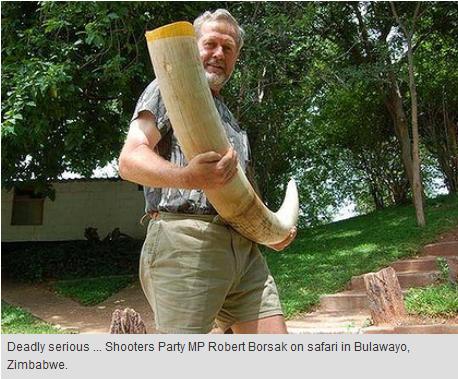
Support from the Coalition of Law Abiding Sporting Shooters Inc (CLASS):
.
‘For too long large areas of bushland has been locked away (aka protected from exploitation) as National Parks, State Forests etc. In many of those parks and forests invasive plants, such as blackberries, bracken, lantana, etc have grown unchecked, resulting in a great unbalance among local flora leading to reduced biodiversity among fauna. Permitting conservation hunting in those areas will help restore the balance, while permitting controlled harvesting of native and introduced species for food, trophies or fur/leather….the Game and Feral Animal Control Amendment Bill 2009 will go a long way to utilising the inherent value of sustainable resources which would otherwise be wasted.’
[Source: ^http://www.c-l-a-s-s.net/game-bill.htm]
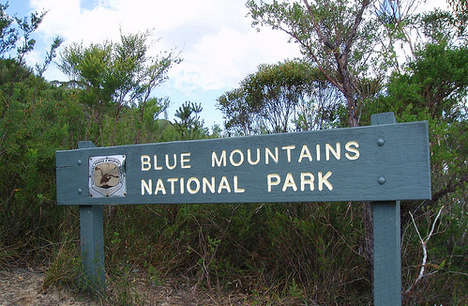 According to CLASS, wildlife in National Parks are wasted resources According to CLASS, wildlife in National Parks are wasted resources
.
.
Selected background articles at the time:

‘Government deal to open national parks to shooters’
.
[Source: Erik Jensen, 20091021, Sydney Morning Herald ^http://www.smh.com.au/environment/conservation/government-deal-to-open-national-parks-to-shooters-20091020-h6yt.html]
.
Hunters will be allowed to shoot animals in national parks for the first time under a deal offered to the Shooters’ Party by the NSW Government. The Herald understands the deal would modify a private member’s bill introduced by a member of the Shooters’ Party, Robert Brown, to allow hunting in 13 national parks if the Shooters’ Party removed demands for enclosed game reserves or safari parks from its draft legislation.
”We have had discussions with senior Labor people,” Mr Brown said. ”I’m not going to confirm or deny that we’re any closer to a resolution … My bottom line is the whole bill must be passed or we continue to withdraw our support for the Government.”
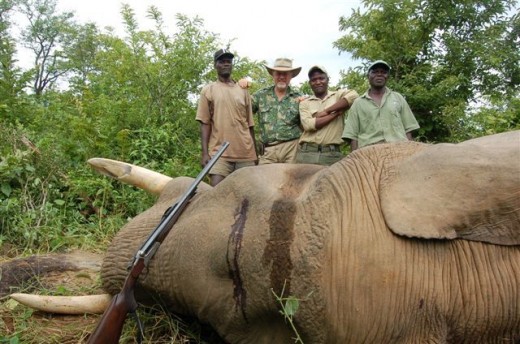
The Shooters’ Party has been holding the Government to ransom since introducing the bill in June and yesterday voted against the Government on all legislation in the upper house. Negotiations on the bill had broken down with the Premier’s chief of staff, Graeme Wedderburn – who Mr Brown described as ”tits on a bull” – but resumed in September, less than a week after John Robertson took over the environment portfolio. The Treasurer, Eric Roozendaal, one of Mr Robertson’s factional allies, took part in negotiations.
According to Mr Brown, the pair offered a memorandum of understanding that would allow hunting in national parks along the Queensland and South Australian borders. But he said the proposed parks were too far away.
”The closest one to Sydney was 10 hours’ drive,” he said. ”That [offer] was there to f— us, as far as I’m concerned.”
The Greens’ spokeswoman on animal welfare, Lee Rhiannon, said the deal was intended to allow free passage of Government legislation through the upper house but may cost Labor seats at the next election – including that of the former environment minister Carmel Tebbutt.
”We’re about to come into the busiest legislation time of the year. They’re going to have to pass 30 bills in a week,” she said. ”If they don’t have the Shooters’ on side, they’ll actually have to talk to other people. [But] as well as being ethically wrong and environmentally damaging, they will be inflicting enormous pain and damage to their own party … For Tebbutt and [Verity] Firth, they could well be putting an expiry date on their political careers.”
The acting executive officer of the National Parks Association of NSW, Bev Smiles, said her office had received an overwhelming amount of correspondence criticising the bill.
”We were hoping the Shooters were having some other face-saving deals with 12-year-olds and airguns,” Ms Smiles said, with reference to another bill the party is introducing.
”[But] with a new Minister for the Environment having an upper house position rather than an electorate, it’s all political. This particular deal has probably created more response from a broader cross-section of the community than any other issue I’ve been involved in.”
Neither Mr Robertson nor Ms Tebbutt would comment on the deal. Mr Brown said he would continue to frustrate government policy until his bill was passed in its entirety.
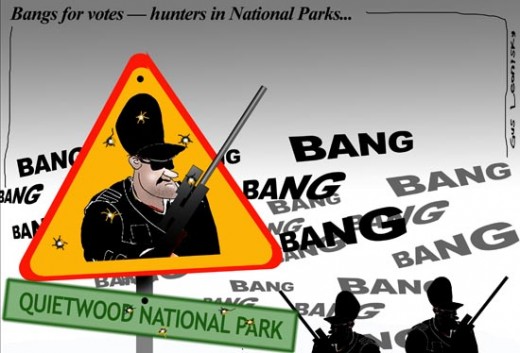
.
.
‘Greens oppose recreational hunting in national parks’
.
[Source: Marian Wilkinson, Environment Editor, Sydney Morning Herald, 20090612, ^http://www.smh.com.au/environment/conservation/greens-oppose-recreational-hunting-in-national-parks-20090611-c508.html]
.
A new bill that would open the state’s national parks and reserves to recreational hunters who could be licensed to shoot native animals and birds has been condemned by the NSW Greens, the Liberal Party and environmental groups.
The NSW Shooters Party has introduced the private members bill to Parliament. It allows for private game reserves to be set up for professional safari hunters, overturning NSW laws that prevent the enclosing of animals on land solely for hunting purposes. A Shooters Party MP, Robert Brown, said the bill would not allow the hunting of threatened species and, in the case of native waterfowl, licensed game hunters would be required to pass an official identification test of the ducks.
But the Opposition’s environment spokeswoman, Catherine Cusack, attacked the bill, saying key elements were unacceptable. “We totally reject the idea of shooting in national parks and the concept of shooting native animals in national parks is repugnant to almost anyone.”
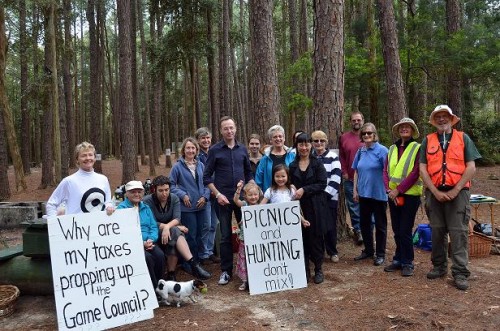
Among the birds and animals that could be hunted are the Australian wood duck, the chestnut teal and grey teal ducks, galahs, corellas and eastern grey, western grey and red kangaroos. The Shooters Party hopes to gain the Government’s support for the bill but the Environment Minister, Carmel Tebbutt, is already signalling she will oppose key provisions in it, including allowing recreational hunters into national parks and the hunting of native animals. Her spokeswoman said the Government would consider the bill’s merits but it did not support “the hunting of native animals or hunting in national parks“.
Mr Brown said the bill drew on many of the recommendations of a government-backed review of existing laws undertaken with staff from the NSW Department of Primary Industries and the Game Council.
He said that under his bill, the environment minister would be responsible for declaring any national park or reserve open to hunters. He told the Herald that opening national parks to recreational hunters to shoot feral animals would save the Government significant amounts of money and the hunting of native animals and birds in parks would require ministerial approval.
The Greens leader, Lee Rhiannon, called on Ms Tebbutt to reject the entire bill, not only the provisions concerning national parks. “Opposing shooting in national parks may well be a tactic Labor is using to divert attention from the fact it will support other equally regressive changes being pushed by the Shooters Party,” Ms Rhiannon said.
The Greens are also concerned about provisions in the bill that would make it an offence to approach anyone or interfere with anyone “lawfully hunting game animals” on any land that had been declared public hunting land.
.
.
‘Shooting in national parks dead: Macdonald’
.
[Source: AAP, 20090729, ^http://www.smh.com.au/environment/conservation/shooting-in-national-parks-dead-macdonald-20090729-e1an.html]
.
A deal with the Shooters’ Party that would allow hunting in national parks is unlikely, the NSW Government says. The Government withdrew its support for the proposal last month, prompting the Shooters to retract their support for legislation to privatise NSW Lotteries management. Primary Industries Minister Ian Macdonald said today the national parks proposal was all but dead in the water.
“The Government has been considering these issues for some time and has taken a policy position that they don’t want that type of shooting activity in national parks,” Mr Macdonald told reporters in Sydney.
“I wouldn’t say it is likely to change, but there again, there’s nothing in life that’s immutable.”
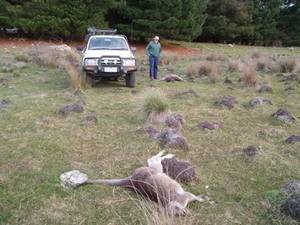
Kangaroos illegally shot through SE Forests National Park
.
.
Game and Feral Animal Control Repeal Bill 2010 – lapsed
.
On 23rd June 2010, then NSW Greens MP Lee Rhiannon introduced a private members bill to the NSW Parliament, ‘Game and Feral Animal Control Repeal Bill 2010’, designed to repeal the Game and Feral Animal Control Act 2002 and its regulations, to abolish the Game Council and to prohibit hunting for sporting or recreational purposes on national park estate land, Crown land and State forests. However although the Repeal Bill reached a second reading stage, the then Labor Premier Kristine Keneally suspended (proroged (suspended) the sitting of the NSW Parliament ahead of an election, and the Bill lapsed on 2nd September 201o.
It needs to be reinstated forthwith!
.
Overview of Bill
The objects of this Bill are as follows:
- To repeal the Game and Feral Animal Control Act 2002 and the regulations made under that Act
- To expressly abolish the Game Council and provide for the transfer of its assets, rights and liabilities to the Crown
- To prohibit hunting for sporting or recreational purposes on national park estate land, Crown land and State forests
.
‘Greens’ Bill abolishes Game Council, ends hunting in State Forests, NP‘
.
[Source: The Australian Greens, 20100624, ^http://greens.org.au/content/greens-bill-abolishes-game-council-ends-hunting-state-forests-np]
.
Greens MP Lee Rhiannon was last night given urgent leave by the NSW Upper House to introduce her private members bill to abolish the NSW Game Council and prohibit recreational hunting in national parks, state forests and public land.
The Game and Feral Animal Control Repeal Bill 2010 is now available.
“Feral animals are a significant environmental problem in Australia but the Games Council, set up as a favour by the Labor Party to the Shooters Party to shore up their vote, is a bankrupt vehicle for managing invasive species,” Ms Rhiannon said. “The more than $11 million in public funding and millions in loans spent propping up the Gaming Council since 2002 would be better spent developing an evidenced based, strategic plan using professionals to tackle invasive species.
“The Game Council was set up to be self funding, yet the Auditor General has noted its ongoing financial difficulties, with the government being forced to prop it up with loans and additional recurrent funding to manage ongoing debt problems.
“Former Premier Bob Carr’s establishment of the Game Council in 2002 was an act of unashamed capitulation to the gun and hunting lobbies, legitimising recreational animal cruelty while risking an increase in feral animal populations.
“The Greens Bill also prohibits recreational hunting in state forests, national parks and Crown Land.
“As part of the deal making between Labor and the Shooters Party, NSW’s state forests have been lately opened up to recreational shooters, risking public safety. “There is still currently a Shooters Party private members bill before parliament which if passed would broaden where recreational shooters can hunt to include national parks.
“The NSW government has agreed to various demands by the Shooters Party for changes to gun ownership laws in recent years and there is no guarantee that shooting in national parks will not be next on the list. “In the interests of the environment and good government NSW Labor should support the Greens’ bill to abolish the Game Council and ensure the professional and scientific management of invasive species in NSW,” Ms Rhiannon said.
.
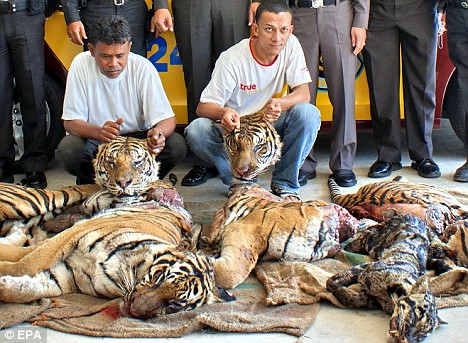
It’s 2011 and we’re still killing Tigers!
[‘Police Seize Firearms Used by Wildlife Officials to Fight Off Poachers‘ by Sarah Pappin, Bushwarriors, 20100716,
^http://bushwarriors.wordpress.com/tag/south-china-tiger/]
.
In only the last eight years, the Bengal Tiger population has decreased by over 61% and is now frighteningly close to extinction with only 1,400 of the cats left. Habitat loss and poaching are to blame for their decline. Nagarhole Tiger Reserve is home to the highest density of these tigers in all of India, attracting a heavy and constant flow of poachers. Forest officers tasked with protecting the National Park’s tiger population (and other wildlife) from the poachers are now impeded by a devastating combination of muddy monsoon conditions and a complete lack of defense.
Comments:
.
Arvind Telkar (20100717): “Poaching is one of the heinous crimes, which must be dealt with a very severe punishment. The law should be changed in such a manner, that he must think hundred times before aiming any wild animal.”
.
Franklin Joel (20100717): “Thank you very much for sharing,I am sharing this on my wall. Please do something to Stop Poaching, My eyes are wet seeing these pictures..The Hon. court should pronounce the highest punishment to these people….”
.
Anne Maher (20100719): “Absolute tragedy. Decisions made by idiots. They must be in on the corrupt poaching activities to leave the Wildlife rangers and the Tigers so unprotected. Spare us from brainless individuals.”
.
Amay (20100903): “What cruel people they are the biggest criminals i hav ever seen in my life how badly these people hav cut the tigers they truly deserve a capital punishment.”
.
Zachary (20101118): “What the hell is wrong with these people?! why don’t they do something to stop this? I don’t give a damn if they think that certain parts have special healing or good luck charms, this is wrong! This is just digusting.”
.
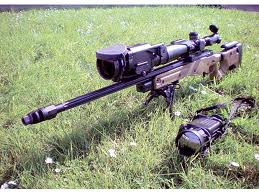 An effective tool against poachers An effective tool against poachers
.
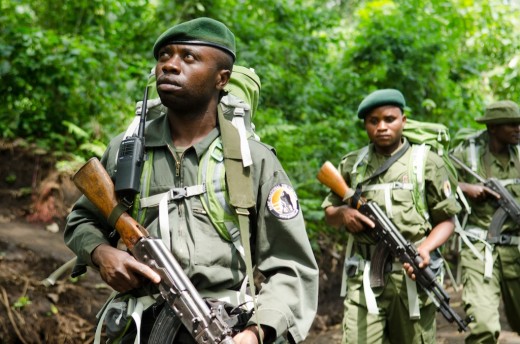 An effective but under-resourced force against poachers An effective but under-resourced force against poachers
.
Tags: animal cruelty, Australian Wood Duck, Bennetts Wallaby, Coalition of Law Abiding Sporting Shooters, Game and Feral Animal Control Amendment Bill 2009, Game and Feral Animal Control Repeal Bill 2010, hunting, hunting season, illegal shooting, Lee Rhiannon, national parks, NSW Game Council, NSW Government, Premier Nathan Rees, SE Forests National Park, Shooters and Fishers Party, still killing Tigers, weekend warriors, Wildlife, wildlife poaching
Posted in Africa, Birds (Australian), Birds (Migratory), Blue Mountains (AU), Elephants, Kangaroos and Macropods, Threats from Poaching and Poisoning | No Comments »
Add this post to Del.icio.us - Digg
Friday, December 2nd, 2011
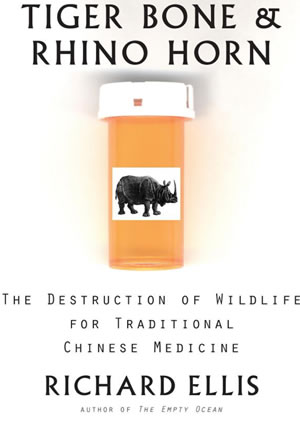
Mass murder is considered possibly the worst crime that can be committed.
But there is a worse crime than mass murder and worse than war crime, and worse than crimes against humanity. Murder; extermination; torture; rape; political, racial, or religious persecution and other inhumane acts reach the threshold of crimes against humanity only if they are part of a widespread or systematic practice.
Even worse than crimes against humanity is the extreme extension of mass murder – genocide. Genocide is “the deliberate and systematic destruction, in whole or in part, of an ethnic, racial, religious, or national group”. What crime could possible be more evil than the willful targeting of an entire part of the human species in order to systematically wipe it out of existence? – such as what has been attempted upon the Jews, Armenians, Rwandan Tutsis, Bosnian Muslims, Sri Lankan Tamils.
 Armenian Genocide 1915 Armenian Genocide 1915
.
“More inhumanity has been done by man himself than any other of nature’s causes.”
~ (1673) by Samuel von Pufendorf
.
Yet still, there is a worse crime. It is the deliberate and systematic destruction, in whole or in part, of an entire species from the planet. In the same vein as genocide, is human-caused extinction or ‘speciescide‘, a relatively new concept. It is new concept because humans have only recently recognised species extinction as a problem. It is also a new concept because the global rate of non-human species extinction is increasing at an accelerating rate.
‘Speciescide‘ is a derived concept from the ecophilosophy of ‘speciesism‘ being a prejudice manifested as a widespread discrimination practised by humans against other species (Richard D. Ryder, 1973).
Yet deliberately causing a species to become regionally extinct, extinct in the wild or globally extinct, are not yet recognised as crimes legally. Human-caused extinction of a species is not yet a criminal offense.
Yet it is the most immoral crime that can be inflicted on the planet. Even if a nuclear holocaust wiped out 6 billion of the human species, there would still be one billion surviving from which to perpetuate the species. But wiping out an entire species is absolute, irreversible, extincting.
The Convention on the Prevention and Punishment of the Crime of Genocide establishes “genocide” as an international crime, which signatory nations “undertake to prevent and punish.”
It says that genocide means any of the following acts committed with intent to destroy, in whole or in part, a national, ethnical, racial or religious group, as such:
- Killing members of the group;
- Causing serious bodily or mental harm to members of the group;
- Deliberately inflicting on the group conditions of life calculated to bring about its physical destruction in whole or in part;
- Imposing measures intended to prevent births within the group;
- Forcibly transferring children of the group to another group.
.
Speciescide is a worse crime than described by the above definition of genocide and even worse than the previous “the deliberate and systematic destruction..” definition.
Speciescide is ecological genocide. It entails annihilating very member of a species until there is no surviving individual on the planet – the entire species becomes globally extinct. They will never be seen again on the planet. Speciescide is thus the worst hate crime possible. Speciescide is what Tasmanian colonists did to the Thylacene. It is what Traditional Chinese Medicine has just committed upon Africa’s Western Black Rhinoceros.
.
.

‘Africa’s Western black rhino declared extinct’
[Source: ‘Africa’s Western black rhino declared extinct’, Los Angeles Times, 20111010, ^http://latimesblogs.latimes.com/world_now/2011/11/africa-western-black-rhino-extinct-conservation.html]
.
Africa’s Western black rhino has officially been declared extinct and other subspecies of rhinoceros could follow, according to the latest review by a leading conservation organization.
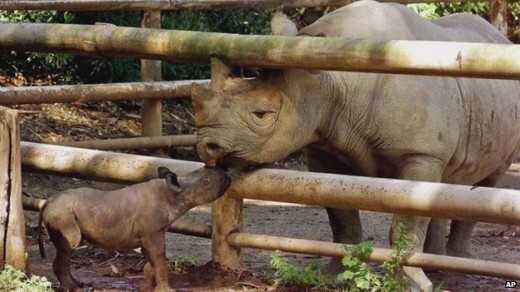 Western Black Rhino and her calf – never again on the planet Western Black Rhino and her calf – never again on the planet
.
The International Union for Conservation of Nature listed the Northern white rhino in central Africa as “possibly extinct in the wild” and the Javan rhino as “probably extinct” in Vietnam.
The organization blamed a lack of political support for conservation efforts in many rhino habitats, international organized crime groups targeting the animal, increasing illegal demand for rhino horns and commercial poaching.
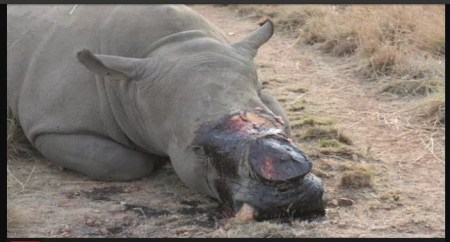
“In the case of both the Western black rhino and the Northern white rhino, the situation could have had very different results if the suggested conservation measures had been implemented,” Simon Stuart, chairman of IUCN’s Species
Survival Commission, said in a statement Thursday. “These measures must be strengthened now, specifically managing habitats in order to improve breeding performance, preventing other rhinos from fading into extinction.”
The last Javan rhino in Vietnam is believed to have been killed by poachers in 2010, reducing the species to a tiny, declining population in Java.
.
The rhinos were among more than 61,900 animal and plant species reviewed for the IUCN’s latest Red List of Threatened Species. A quarter of the mammals on the Red List were found to be at risk of extinction. But the organization said there
have also been conservation successes. Fewer than 100 Southern white rhinos survived at the end of the 19th century, but the population in the wild is now believed to number over 20,000. Numerous other species are threatened, including many types of plants. The Chinese water fir, which used to be widespread throughout China and Vietnam, was listed as “critically endangered,” due primarily to expanding intensive agriculture. The IUCN also listed five out of eight tuna species as “threatened” or “near threatened,” and added 26 recently discovered amphibians to the Red List, including the blessed poison frog.
“This update offers both good and bad news on the status of many species around the world,” said Jane Smart, director of the IUCN Global Species Program. “We have the knowledge that conservation works if executed in a timely manner, yet, without strong political will in combination with targeted efforts and resources, the wonders of nature and the services it provides can be lost forever.”
 Stumpy’s lifeless body, her life stolen by poachers
(Photo credit: Lewa Wildlife Conservancy)
. Stumpy’s lifeless body, her life stolen by poachers
(Photo credit: Lewa Wildlife Conservancy)
.
‘Stumpy was the oldest female black rhino at the Conservancy, and had spent 26 years enjoying her freedom on the property. Her eighth calf, only a year and a half old, was dealt a minor wound to the neck in the incident and will survive. Coincidentally, on the day Stumpy drew her last breath, a first breath was taken by a newborn rhino at the rhino refuge.’
.
[Source: ^http://bushwarriors.wordpress.com/tag/rhino-horn-trade/page/6/]
.

.
.
‘DEAD MEN DON’T DEAL’ Campaign
.
Rhinos have been slaughtered to near extinction to satisfy the demand of rhino horn products in China and Vietnam. All based on rhino horn cultural myths. It has the same effect as chewing ones fingernails.
China is costing the world its rhinos.
.
- It is seen as a remedy for nearly everything (evil possession included) in China and Vietnam
- China and Vietnam fund international organized poaching teams to kill rhino.
- Science proves there is no medicinal value about rhino horn.
- Rhino is said to be the most endangered species to date.
.
However, even if Chinese trade makers are aware that the Rhino population is on near brink to extinction; the continual demand for rhino horn persists.
Unless a serious measure evolves, Chinese businessmen will not stop.
(Ed: This is speciescide)

So, the idea sprung to mind to form a campaign that will create a cultural scare. Namely, the DEAD MEN DON’T DEAL campaign that revolves around the sudden deaths of dealers. Without knowing who or how these smugglers are tortured it will create a cultural scare amoungst those who are guilty. The idea derives from laying revenge out into the air. The revenge of the rhino. Getting back at those who took away a lot of the rhino population. The main objective here is to create fear for those who are involved in the illegal dealing of rhino horn.
.
Dehorning
The demand for Rhino has become so high that conservation officials have gotten to the point where they actually saw off their horns so rhino poachers will have no cause to kill them. These desperate measures have raised questions if removing Rhino horn impairs the rhino’s ability to survive or reproduce; one usage of the horn is to defend a mother’s young from predators.
Many parks and game reserved have battled the on going poaching around this endangered specie. Dr David Mabunda- Chief executive of SANParks stated that it is no longer appropriate to refer to this illegal action as poaching anymore as the levels of sophistication, violence and money behind it continue to raise. He also stated that the country has been working hard to bring this nearly extinct specie back, even if it requires one to become the last standing man.
Endangered stats continue to rise as reports keep coming in. In January an epidemic occurred where poachers were found using aircraft to hunt down rhino in Harare-Zimbabwe, as demand in Asia was great due to medicinal benefit growth. 7 endangered rhinos were killed, this representing one third of 22 rhinos poached throughout 2010. South Africa has about 1000 surviving rhino’s n which extra help for their existence has been sent, last year 333 rhinos were poached in South Africa nearly three times as many then 2009. However, 2011 proves to have lowered the killings. South Africa has over 21 000 more rhinos then any country in the world which puts the country as well as the animals in greater danger.
Demands in Vietnam have been noticed to increase. The black market offers huge amounts of money for trading these species for Traditional Chinese Medicine such as high blood pressure and other impairments. Experts state that as little as 5 rhinos remain in Vietnam. South Africa has become internationally known for banning rhino horn distribution.
World efforts to ‘demystify’ the medicinal affects of rhino horn fail to reach Asia and thus the uproar continues.
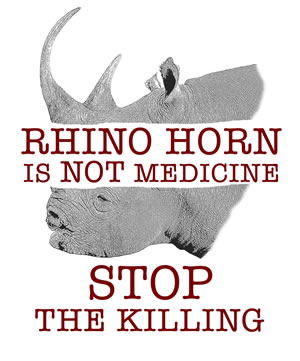
[Source: ^ http://savetherhino.wordpress.com/]
.
.
“For one species to mourn the death of another is a new thing under the sun. The Cro-Magnon who slew the last mammoth thought only of steaks. The sportsman who shot the last passenger pigeon thought only of his prowess. The sailor who clubbed the last auck thought of nothing at all. But we, who have lost our pigeons, mourn the loss. Had the funeral been ours, the pigeons would hardly have mourned us. In this fact, rather than in Mr. DuPont’s nylons or Mr. Vannevar Bush’s bombs, lies objective evidence of our superiority over the beasts.”
.
~ Aldo Leopold: ‘A Sand County Almanac, and Sketches Here and There‘, 1948, Oxford University Press, New York, 1987, pp. 109-110.
.
.
.
Further Reading:
.
[1] Book: ‘ Tiger Bone and Rhino Horn: The Destruction of Wildlife for Traditional Chinese Medicine‘
by Richard Ellis
Format: Hardcover, 294 pages, Revised and Tea Edition
Release Date: 27 May 2005
‘In parts of Korea and China, moon bears, black but for the crescent-shaped patch of white on their chests, are captured in the wild and imprisoned in squeeze cages, where steel catheters drain their bile as a cure for ailments ranging from upset stomach to skin burns. Rhinos are being illegally poached for their horns, as are tigers for their bones, thought to improve virility. Booming economies and growing wealth in parts of Asia are increasing demand for these precious medicinals while already endangered species are being sacrificed for temporary treatments for nausea and erectile dysfunction. Richard Ellis, one of the world’s foremost experts in wildlife extinction, brings his alarm to the pages of “Tiger Bone & Rhino Horn”, in the hope that through an exposure of this drug trade, something can be done to save the animals most direly threatened. Trade in animal parts for traditional Chinese medicine is a leading cause of species endangerment in Asia, and poaching is increasing at an alarming rate. Although most of traditional Chinese medicine is not a cause for concern because it relies on herbs and other plants, as wildlife habitats are shrinking for the hunted large species, the situation is becoming ever more critical. Ellis tells us what has been done successfully, and contemplates what can and must be done to save these rare animals from extinction.’.
[Source: ^http://www.fishpond.com.au/Books/Tiger-Bone-and-Rhino-Horn-Richard-Ellis/9781559635325]
.
.
.
Tags: China, ecological genocide, ecophilosophy, extincting, Richard Ellis, speciescide, speciesism, TCM, TCM witchdoctor cult, tiger bone and rhino horn, Traditional Chinese Medicine, Vietnam, Western Black Rhino extinct, wildlife poaching
Posted in 21 Going Khaki!, Rhinoceroses, Threats from Poaching and Poisoning, Tigers | No Comments »
Add this post to Del.icio.us - Digg
Thursday, December 1st, 2011
Corporate Tin Miner:
“We will continue to be aggressive explorers with multiple rigs focused on exploration for the foreseeable future.”
.
~ Venture Minerals (corporate tin miner from Perth), in its Mt Lindsay-Investor Presentation,
(Nov 2011), p.31
.
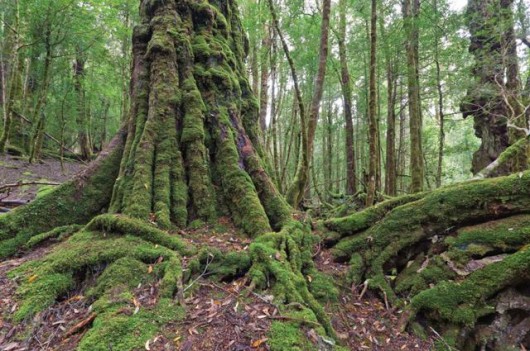 ‘The Tarkine’ – 430,000 hectares of ancient Tasmanian forest ‘The Tarkine’ – 430,000 hectares of ancient Tasmanian forest
Tasmania’s ancient Myrtle/Sassafras forest – threatened by loggers, logger ‘adventure tourism’, roads and now bloody tin mining!
[Photo by Peter Walton, Tasmanian Expeditions – Photo Gallery on The Tarkine, ^http://www.tasmanianexpeditions.com.au/index.php?section=photo_highlights&id=285742]
.
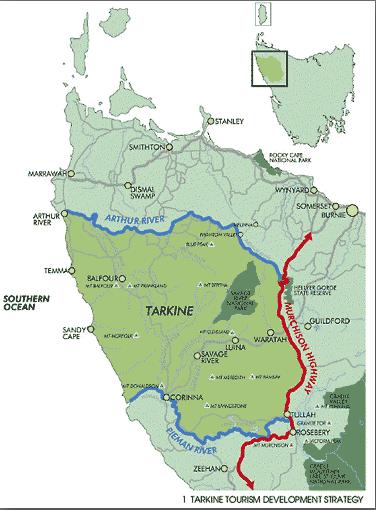 Cradle Coast Authority (CCA), North West Tasmania’s map
as part of a tourism development strategy. Cradle Coast Authority (CCA), North West Tasmania’s map
as part of a tourism development strategy.
.
A bid to restore emergency National Heritage protection to the Tarkine wilderness in Tasmania’s north-west has been launched by environmentalists to head off a ”Pilbara-style” mine in the rainforest. Several conservation groups lodged the nomination with the Environment Minister, Tony Burke, hoping he will count heritage values in his impending decision on the big Venture Minerals’ Mount Lindsay open cut project.
Emergency listings of The Tarkine have been granted four times since 2004!
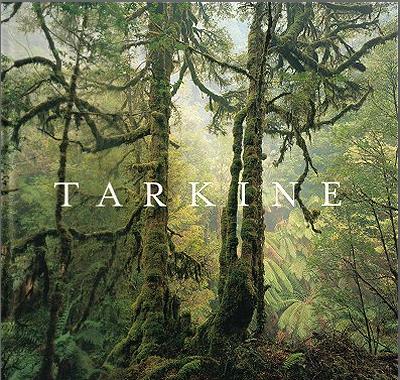 Moss-clad Sassafras (Atherosperma moschatum) trees in the Arthur River catchment near Waratah, Tarkine, Tasmania
(Photo © Ted Mead November 2003)
[Front Cover of the 2004 book, ‘Tarkine‘ edited by Ralph Ashton, and available from publishers Allen and Unwin,and just purchased by The Habitat Advocate.
Available at: ^http://www.allenandunwin.com/default.aspx?page=94&book=9781742372846]
Moss-clad Sassafras (Atherosperma moschatum) trees in the Arthur River catchment near Waratah, Tarkine, Tasmania
(Photo © Ted Mead November 2003)
[Front Cover of the 2004 book, ‘Tarkine‘ edited by Ralph Ashton, and available from publishers Allen and Unwin,and just purchased by The Habitat Advocate.
Available at: ^http://www.allenandunwin.com/default.aspx?page=94&book=9781742372846]
.
…but that’s not how the ‘Tin Men‘ see The Tarkine…
 This is how the ‘Tin Men‘ see the Tarkine… for its tin and tungsten.
(Source: Venture Minerals’ Mt Lindsay-Investor Presentation, Nov 2011) This is how the ‘Tin Men‘ see the Tarkine… for its tin and tungsten.
(Source: Venture Minerals’ Mt Lindsay-Investor Presentation, Nov 2011)
.
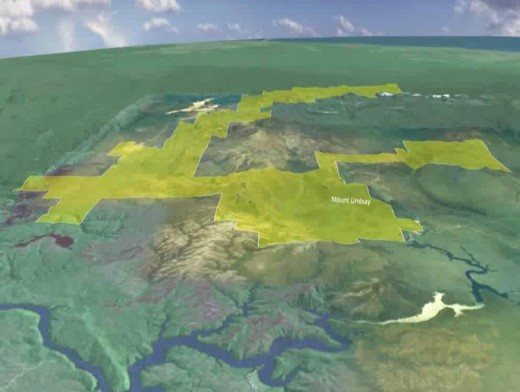 …and this is how the ‘Tin Men’ see the Tarkine… for the vast mining lease area they are happy to exploit and lay to waste. …and this is how the ‘Tin Men’ see the Tarkine… for the vast mining lease area they are happy to exploit and lay to waste.
(Source: Venture Minerals’ Mt Lindsay-Investor Presentation, Nov 2011)
.
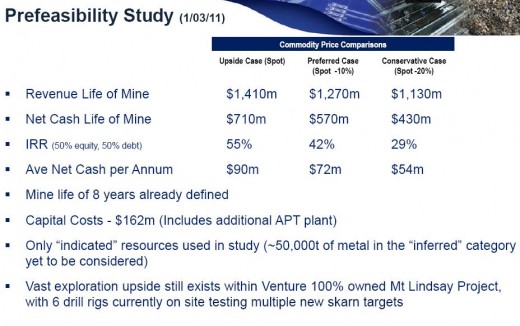 …and this is how the Tin Men see the Tarkine – for its ‘Super Mining Profits’ … 30 to 55% return! …and this is how the Tin Men see the Tarkine – for its ‘Super Mining Profits’ … 30 to 55% return!
(Source: Venture Minerals’ Mt Lindsay-Investor Presentation, Nov 2011)
.
The Mount Lindsay tin project is the largest of several mines planned around the Tarkine in an emerging new Tasmanian environmental battle. The Tarkine National Coalition said up to nine new open cut mines are in development there. Mr Burke allowed a previous emergency listing for the Tarkine to lapse a year ago when he said plans for a road through the wilderness were dropped. Environment groups objected because of what they said were increasing threats from mining.
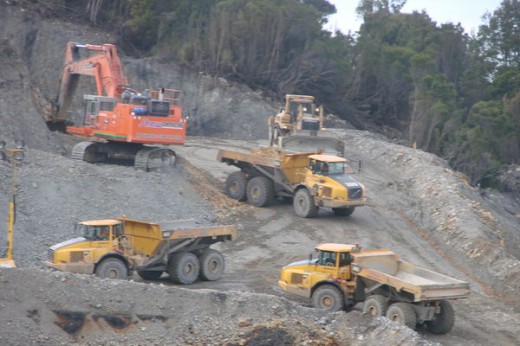 Corporate Miner ‘Metals X’ getting well stuck into a Tarkine rainforest hillside at nearby Mount Bischoff Corporate Miner ‘Metals X’ getting well stuck into a Tarkine rainforest hillside at nearby Mount Bischoff
.
The 430,000-hectare Tarkine region is undergoing a protracted assessment for future listing by the Australian Heritage Council. But because the wilderness now lacks any listing, Mr Burke is unable to consider heritage values in an approval of the Mount Lindsay mine under the Environment Protection and Biodiversity Conservation Act. Instead, his decision is likely to focus on protection of endangered species such as the Tasmanian Devil. The Tarkine is the wildest remaining stronghold for healthy devils, stricken across the rest of the island by a deadly facial cancer.
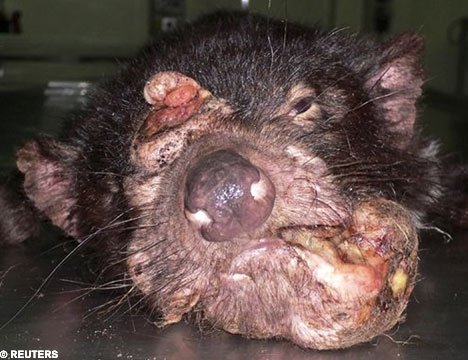 The Tarkine is a refuge for healthy Tasmanian Devils to avoid the genocidal tumour disease
..but what could heartless commercial ‘Tin Men’ care?
Think of the ‘Super Mining Profits’ … 30 to 55% return! The Tarkine is a refuge for healthy Tasmanian Devils to avoid the genocidal tumour disease
..but what could heartless commercial ‘Tin Men’ care?
Think of the ‘Super Mining Profits’ … 30 to 55% return!
.
The Tarkine National Coalition spokesman Scott Jordan said yesterday:
”Companies, including Venture, are using the removal of the heritage protections to ramp up exploration activities including roading and drilling that are having a significant effect on the values of the area.”
.
The coalition was joined by the World Wildlife Fund, the Australian Conservation Foundation and The Wilderness Society in seeking the listing. An Australian National University environmental law specialist, Andrew Macintosh, said emergency listings had been granted four times since 2004, but Mr Burke was not compelled to respond to the request. In a statement, Mr Burke did not respond directly to the emergency listing request, but said he would continue meeting with different groups on issues surrounding the heritage listing of the Tarkine. [Editor’s note: in fact there has been one emergency National Heritage listing (Dec 2009 – Dec 2010), one National Heritage nomination (2004), three emergency National Heritage nominations (Nov 2009, Mar 2011 and Nov 2011), and two AHC recommendations (2003 and Sep 2010)… so what’s it bloody take to get the message through?]
.
[Source: ‘ Call for heritage listing of the Tarkine to head off tin mine‘, Sydney Morning Herald, 20111119, ^ http://www.smh.com.au/national/call-for-heritage-listing-of-the-tarkine-to-
head-off-tin-mine-20111118-1nndq.html]
.
.
‘Jobs, jobs, jobs’ justification – but all for mainlanders, foreigners and short-termers
.
Typically, this miner (Venture Minerals) relies on the standard jobs justification to exploit, dig up, pollute and destroy the Tarkine Wilderness for tin. Venture Mineral is promising 700 jobs! But of those , 500 jobs involve construction – so short term fly ins from the mainland and overseas only during construction phase. The remaining 200 jobs are promised for the mine’s operations. But miners don’t train locals. This is not about Tasmanian jobs. These 200 jobs will be sourced from similar mines on the mainland and indeed from overseas all on on Federal Labor’s 457 Visa (Australian worker displacement) Scheme. Just look at OZ Minerals at Rosebery.
457 Visas: ‘..for employers who would like to employ overseas workers to fill nominated skilled positions in Australia, to employ overseas workers for a period of between one day and four years.’
[Source: ^http://www.immi.gov.au/skilled/skilled-workers/sbs/]
.
Venture Minerals is Perth-based at 181 Roberts Road Subiaco, another West Australian corporate miner exploiting Tasmania and taking the profits offshore. Venture Minerals forecasts $1 billion in revenue but it won’t go to Tasmanians. It will go back to West Australia and to its rich mine shareholders. Typically mining is eco-rape, pillage and plunder – wam, bam, thank you mam, then pissing off back to where one came, leaving another tin moonscape like Mount Bischoff.
Look at the mining legacies across Tasmania left as moonscapes:
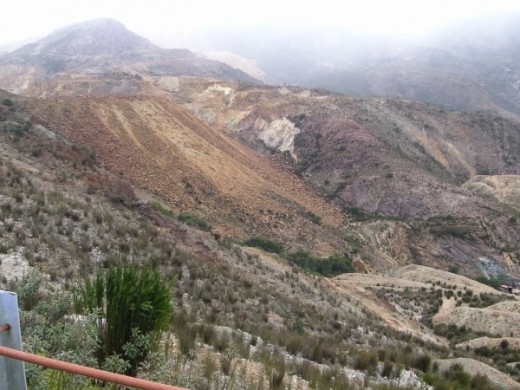 Nearby Mount Bischoff Tin Mine – wam, bam, thank you mam! Nearby Mount Bischoff Tin Mine – wam, bam, thank you mam!
.
- Kara Mine in Hampshire
- Mount Lyle’s sulphuric moonscape
- Henty Mine
- Briseis Mine at Derby
- Pioneer Mine on Bradshaws Creek
- Anchor Mine on Blue Tier
- Gladstone Mine
- Coles Bay Mine
- Ben Lomond Mine
- St Paul’s River Mine
- Flinders Island Mines
- Mount Heemskirk
- Mount Balfour
- Renison Bell
- Stanley River
- Mount Cleveland
- Cox Bight
- Melaleuca
- etc

And of course the Tasmanian Minerals Council backs mining in The Tarkine. And of course it opposes national heritage listing of the Tarkine. The Tasmanian Minerals Council is only about the financial bottom line, exploitation of ore and perpetuating its own existence.
 The Tasmanian Minerals Council claims that there are “already enough layers of protection across the Tarkine region, where about 80% of the land has been put in multiple use reserves that allow mining“. The Tasmanian Minerals Council claims that there are “already enough layers of protection across the Tarkine region, where about 80% of the land has been put in multiple use reserves that allow mining“.
What ‘layers of protection’? If 80% of the Tarkine is reserved form mining, how can that be for protection? – for protection of mining profits and royalties perhaps.
So Tony Burke, if you’re not to pre-occupied with resolving the future of the Murray-Darling, what time are you allocating for Tasmania’s ancient Myrtle forests?
.
.
.
‘Tasmania’s Tarkine wilderness is one of the world’s largest temperate rainforests.
This vast expanse is a wilderness wonderland of wild rivers, dramatic coastal heathlands, button grass plains, bare mountains, ancient Huon pines, giant eucalypts and myrtles and extraordinary horizontal scrub.
It is home to rare and endangered birds – like the Orange-bellied parrot and the White goshawk – and countless animals such as the Eastern pygmy possum. This superbly illustrated book captures the beauty of this unique wilderness.’
.
[Source: ^http://www.andrewisles.com/all-stock/publication/tarkine]
.
Orange-bellied Parrot
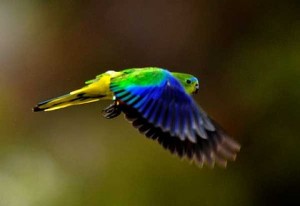 ‘Here at Melaleuca, six days’ walk from the nearest road,
such moments of peace are typically broken by bird calls,
including the distinct buzzing of the orange-bellied parrot’.
.
[Source: ‘Scientists Race To Rebuild Parrot Population’, by Peter Ker, Sydney Morning Herald, 20110207, ^http://www.globalanimal.org/2011/02/07/scientists-race-to-rebuild-parrot-population/29032/] ‘Here at Melaleuca, six days’ walk from the nearest road,
such moments of peace are typically broken by bird calls,
including the distinct buzzing of the orange-bellied parrot’.
.
[Source: ‘Scientists Race To Rebuild Parrot Population’, by Peter Ker, Sydney Morning Herald, 20110207, ^http://www.globalanimal.org/2011/02/07/scientists-race-to-rebuild-parrot-population/29032/]
.
Current status:
‘The Orange-bellied parrot (Neophema chrysogaster) is one of 18 birds listed as endangered under the Tasmanian Threatened Species Protection Act 1995. It is also listed as endangered under the Federal Act and has the dubious honour of being one of the most endangered birds Australia wide.
Why is it endangered? The Orange-bellied parrot is endangered because it is so rare (only 200 birds left) and its habitat is quickly disappearing.
.
There are only about 50 breeding pairs of this bird left!
..but what could heartless commercial ‘Tin Men’ care?
Think of the ‘Super Mining Profits’ … 30 to 55% return!
.
‘…It is a breeding endemic of Tasmania, which means that it only breeds in Tasmania. In fact it only breeds in one place in Tasmania and that is in our Southwest National Park. It arrives here in summer, nesting in eucalypt tree hollows adjacent to the parrot’s feeding grounds of extensive coastal buttongrass plains.’
.
[Source: http://www.dpiw.tas.gov.au/inter.nsf/webpages/bhan-54g3c5?open]
.
Tags: 457 visas, Cradle Coast Authority, Environment Minister, high priority drill targets, Melaleuca, Metals X, Mount Lindsay, Orange-bellied Parrot, Pieman River, super mining profits, Tarkine Tourism Development Strategy, Tarkine Trails, Tarkine wilderness, Tasmania, Tasmanian Devil, Tasmanian Minerals Council, The Tarkine, tin man, tin men, tin mine, Tony Burke, tungsten mine, Venture Minerals, wam bam thank you mam
Posted in Birds (Australian), Tasmania (AU), Tasmanian Devils, Threats from Mining, Threats to Wild Tasmania | 8 Comments »
Add this post to Del.icio.us - Digg
Friday, November 18th, 2011
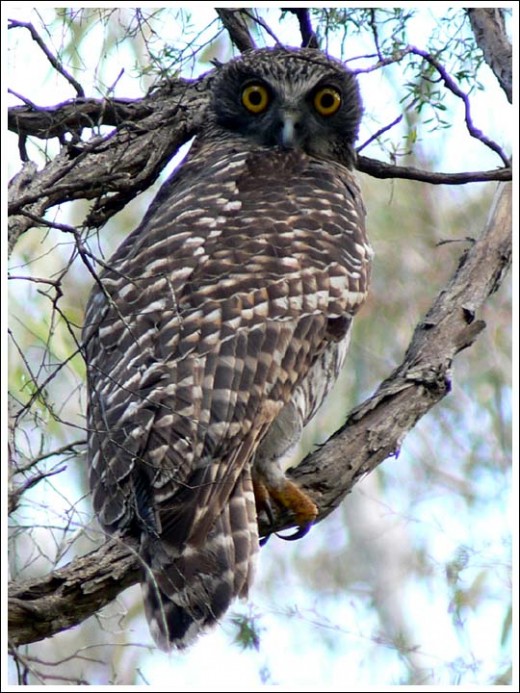 Powerful Owl (Ninox strenua)
(© Photo by Duncan Fraser, ^http://bencruachan.org/blog/?p=170) Powerful Owl (Ninox strenua)
(© Photo by Duncan Fraser, ^http://bencruachan.org/blog/?p=170)
.
The Powerful Owl (Ninox strenua) is Australia’s largest owl, yet in Victoria it has become a threatened species due to human destruction of old growth forest habitat; particularly the destruction of hollow-bearing trees used by this owl for nesting, roosting and home for its natural prey – possums. ‘Powerful Owls are adversely affected by the clearfelling of forests and the consequent conversion of those forests into open landscapes, but the species may persist in forests that have been lightly or selectively logged.’
[Source: ^http://www.birdsaustralia.com.au/our-projects/powerful-owl-wbc.html]
.
Since European settlement, 65% of Victoria’s forest cover has been cleared (Woodgate & Black 1988). Only 5% of freehold land remains forested. This past permanent loss of habitat has likely led to an overall reduction in owl numbers and fragmentation of the original continuous population into a series of small residual populations, each of which is at risk of becoming locally extinct.

‘It is estimated that hollows suitable for owls do not form, even in the fastest-growing eucalypts, until they are at least 150-200 years of age (Parnaby 1995). Of 21 nest trees observed by McNabb (1996) in southern Victoria, about 50% were senescent and all ranged between 350-500 years of age, based on data collected by Ambrose (1982).
Over much of its range, the lack of suitably large hollows is considered to be a limiting factor to successful breeding and population recruitment. The Powerful Owl is, therefore, vulnerable to land management practices that reduce the availability of these tree hollows now or in the future. The loss of hollow-bearing trees has been listed as a potentially threatening process under the Flora and Fauna Guarantee Act (SAC 1991).
In addition, prey density may be an important determinant in territory size and breeding success, particularly considering that only the male hunts during the breeding season. Seebeck (1976) estimated that about 250 possums (or their equivalent) would be required per year by a family group and recent studies have estimated around 300 prey items for a breeding pair rearing two young (Webster unpubl. data.). Key prey are also dependent on hollow trees.’

In its final recommendation the Scientific Advisory Committee (SAC 1994) has determined that:
‘the Powerful Owl is significantly prone to future threats which are likely to result in extinction, and very rare in terms of abundance or distribution.’
.
The short-term conservation objective is to prevent further decline by ensuring that good quality habitat for at least a population target of 500 breeding pairs of Powerful Owl is maintained on public land in Victoria.
[Source: ‘Powerful Owl Action Statement‘, Victorian Government’ s Department of Natural Resources and Environment (or whatever its latest incarnation is), ^http://www.oren.org.au/issues/endspp/powerfulowlAS.htm]
.
.
‘Impact of Bushfire on Sooty Owls and Powerful Owls’
[Source: Rohan Bilney, Report on Sooty Owls and Powerful Owls for the Supreme Court proceeding number 8547 of 2009 – Environment East Gippsland v VicForests, pp.12-13]

Greater Sooty Owl (Tyto tenebricosa)
.
‘Fire is likely to kill individual owls and small mammals, and remove potential habitat in the short-term, potentially resulting in long-term impacts.
‘How owl populations adapt or respond to fire is largely unknown’
.
‘Fire can consume hollow-bearing trees, while also stimulating hollow formation, but as hollow formation can take decades, frequent fires are likely to result in a net loss of hollow-bearing trees from the landscape (Gibbons and Lindenmayer 2002). This is likely to cause detrimental effects to all hollow-dependant fauna (Catling 1991; Gibbons and Lindenmayer 2002; Garnett et al. 2003).
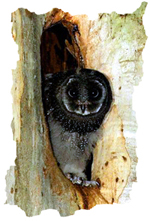
‘Sooty Owls typically occupy habitats subject to infrequent fire regimes such as wetter forest types, possibly due to higher densities of hollow-bearing trees in such landscapes. Frequent fire regimes also simplify habitat structure, which can cause deleterious impacts on terrestrial mammals (Catling 1991; SAC 2001), which includes increased predation rates by feral predators due to the loss of habitat refuge (Wilson and Friend 1999). Overall, it therefore seems likely that owls and small mammals will be negatively impacted by frequent fire regimes. It is likely, however, that it will be the impacts of fire on prey densities that dictate how the owls respond to fire.
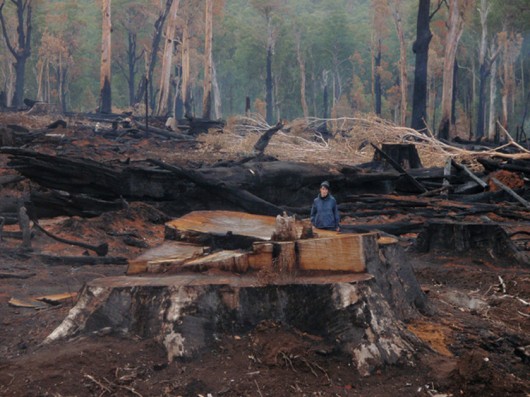 Brown Mountain ancient old growth logged, incinerated, razed by VicForests
(Photo by Environment East Gippsland) Brown Mountain ancient old growth logged, incinerated, razed by VicForests
(Photo by Environment East Gippsland)
.
‘Most species are not adapted to fire per se, but adapted to a particular fire regime, which include fire aspects such as intensity, frequency, seasonality and scale (Bradstock et al. 2002). Due to variations in the life history requirements of species and their ability to survive fire, particular fire regimes can advantage some species, while being deleterious to others (Bradstock et al. 2002; Gill and Catling 2002; Keith et al. 2002). Due to the varying ecological responses to fire, it is important for biodiversity conservation that we not only understand species responses to particular fire regimes, but to ensure that appropriate fire regimes are maintained across the landscape. As prescribed fire is used as a management tool for reducing fuel load to minimise fire risk, it is important that its effects on biodiversity are well understood.
‘Unfortunately, knowledge on how native species respond to particular fire regimes is poorly understood, especially for fauna (SAC 2001, 2003; Clarke 2008). So, in the absence of this crucial ecological information it is virtually impossible to implement appropriate fire regimes which will result in minimal negative ecological impacts, let alone enhance biodiversity. Fire, both prescribed burning and wildfire, can present a threat to owls if conducted at inappropriate seasons, frequency, intensity or scales. It is therefore difficult to quantify the threat. The threat of inappropriate burning at high fire frequencies is likely to be mainly concentrated around human assets and populations, while fires in more remote forested areas will be subject to less frequent fires (DSE 2004). Fire also affects the entire owl population because all habitats occupied by owls is flammable.
‘Victoria has experienced three catastrophic fire events in the past 7 years, and combined with prescribed burning, approximately three million hectares have been burnt in this time.‘
‘This equates to approximately 2/3 of potential Sooty Owl habitat in Victoria. How populations of Sooty Owls and many other forest dependant fauna have been affected by these fires remains poorly understood or unknown. The ability for forest fauna to recover is therefore being hampered by further prescribed burning, and recovery is also hampered by reduced fecundity caused by a decade of drought, and for the owls, low prey population densities.’
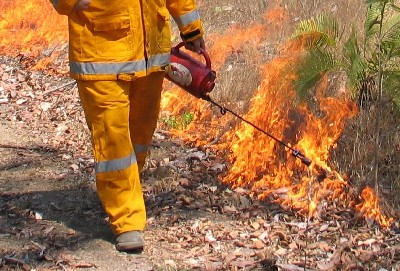
.
.
The ‘Bushfire Fighting Principle’ corrupted by blinkered economic rationalism
.
The traditional principle of bushfire management is to put out bushfires…one would think. Yet this simple concept has been hijacked, bastardised and corrupted by successive governments as a consequence of systemic under-resourcing. Government under-resourcing has contributed to the deadly human toll in recent years.
The corrupting of this core bushfire management principle has morphed into a blanket one-size-fits-all defeatist policy of broadscale prescribed burning – burning the bush before it burns. The bushfire management tradition of ‘suppression‘ has been economically rationalised and politically supplanted by the proactively sounding notion of ‘prevention‘.
In Victoria, the fundamental job of putting out bushfires has bureaucratically morphed into a ‘Code of Practice for Fire Management on Public Land’, with its two general principles…
.Fire management planning on public land must address the threat of wildfire, guide the use of prescribed burning, and provide for the achievement of integrated land management objectives such as human safety and environmental management.’ (Clause 50)
‘Fire management activities must be undertaken in a participative manner where the responsibility for reducing the likelihood and consequence of wildfire is appropriately shared between public and private land holders and managers.’ (Clause 51)
.
What happened to the fundamental principle of bush fire fighting?
To put out bushfires!
Instead, vast areas of remaining native bushland and forests across Australia are being deliberately burnt to the point where critical faunal habitat is sterilised – only the trees remain, while the rich underlying vegetation, demonised as ‘hazardous fuel‘ is incinerated and repeatedly prevented from regrowth. Wildlife habitat has become a fuel hazard targeted for burning by the very custodians charged with wildlife conservation. And out of the Victorian Royal Commission into the Black Saturday bushfires, the anticipated kneejerk response by bushfire agencies to commence Prescribed Burning Armageddon against the bush has started as many genuine conservationists have feared.
And what has been the full realised cost of the 2009 Victorian Bushfires – valuing human lives, human injuries, ongoing trauma, livelihoods, wildlives, livestock, private property, natural assets, on top of the direct operational response cost, the indirect costs of contribiting agencies, the donations raised, capital costs, the opportunity costs, the investigation costs, the Royal Commission costs? No one has come up with a figure. These values were outside the Victorian Royal Commission’s terms of reference – so what real value was it? Economic rationalising of emergency management is costing lives and contributing to species extinctions.
.
.
Victorian Government Policy of Bushfire Lighting
.
The Victorian Government’s delegated custodian on natural areas across the State is the infamous Department of Sustainability and Environment (DSE), with a reputation for lighting most of the bushfires it euphemistically labels as ‘prescribed burning’ wherein it finds unburnt bushland and prescribes its own burning regimes. When such custodial agencies restore the word ‘conservation‘ back into their title, some respect may return.
DSE’s ‘Code of Practice for Fire Management on Public Land‘ was revised in 2006. It relies upon background premises that since “much of the Australian continent is fire-prone”, that “fire occurs naturally”, that “many species of vegetation and wildlife have adapted to living within the natural fire regime” and that “Victoria’s Indigenous people used fire as a land management tool for thousands of years”. The Code justifies that “Victoria’s flora, fauna and the ecosystems they form are adapted to fire of varying frequencies, intensities and seasonality.” Victoria’s Flora and Fauna Guarantee Act 1988 has objectives to ensure “Victoria’s native flora and fauna can survive, flourish, and retain their potential for evolutionary development”. Now the integrity of this Act is under threat. Perversely DSE’s Code of Practice argues that deliberate burning of bushland and forest habitat will help Victoria’s native flora and fauna to survive, flourish, and retain their potential for evolutionary development.
Crap!
DSE stretches its rationalising propaganda further, claiming that excluding bushfire can have “negative consequences for Victoria’s flora and fauna“. And this is where the hijacking, bastardisation and corrupting turns from mythology into unsubstantiated falsehood and misinformation. No document exists to zoologically prove that native fauna will suffer such negative consequences if it does not have a bushfire range through its habitat. As a result, the Code of Practice implies that bushfire is ok for all Victorian bushland and forests – DSE conveniently convinces itself that the urgent moral imperative for DSE to suppress bushfires is extinguished. So now it lights more fires than it puts out.
The Code also premises that “often these wildfires can be difficult to suppress”. Well no wonder with an grossly under-resourced, firetruck-centric volunteer force.
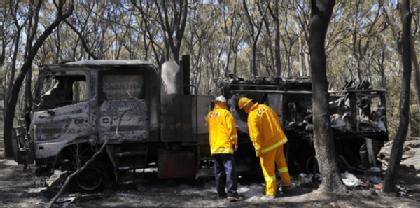 . .
.
‘DSE holds fire management workshop in Bendigo’
.
On 22nd June 2011, DSE staged a workshop of stakeholders to discuss some recommendations of the Royal Commission into Victoria’s February 20o9 bushfire tragedy. According to the website ‘Friends of Box-Ironbark Forests’, in attendance were representatives from the CFA, local government, The Wilderness Society, Bendigo Field Naturalists Club, Friends of Kalimna Park, North Central Victoria Combined Environment Groups [NCVCEG], Apiarists Association and DSE attended a workshop on June 10 to learn about the process for implementing the findings of the Victorian Bushfires Royal Commission. Though Friends of Box-Ironbark Forests (FOBIF) was not invited to this workshop, we were represented by members of some of the other groups.
Once again DSE’s Code of Practice for Fire Management on Public Land (COP) is to again be reviewed and updated, except its premises have not changed, so what’s the point? The following notes taken on the issue of Fire management Zones/Prescriptions is telling of how disconnected DSE is from wildlife habitat conservation:
.
‘Fire Management Zones (FMZ) have been reviewed recently. An interim zoning is to be released soon. With little time left the group briefly discussed the merits of fire management zones, and how they might relate to the risk model. It was highlighted that the residual fuel load is an important aspect, but further detail as to how was not provided.
NCVCEG made the point that the current diagram used by DSE to represent the relationship between ecological outcomes and fire management outcomes across the four FMZ is misleading, encourages poor planning, discourages biodiversity management in zones 1 and 2, and neglects to recognise that fire management outcomes may be achieved in all zones, especially where integrated planning and alternative practices (to prescribed burning) are established.
In relation to FMZ the Apiarists pointed out that Box Ironbark forests generally have very low fuel levels in comparison to heavily forested regions where many lives were lost during the fires in 2009. The merit of burning areas used for honey production was questioned and the long term impacts of severe burning on Box Ironbark forest ecology was raised.’
.
[Source: Friends of Box-Ironbark Forests, 20110622, ^http://www.fobif.org.au/2011/06/dse-holds-fire-management-workshop-in-bendigo/]
.
.
Yet at the same time DSE points out that… ‘biodiversity is in decline‘
.
In its ‘Victoria’s Biodiversity Strategy 2010–2015: Consultation Draft‘ DSE reminds us that two hundred years of (immigrant deforestation), severe droughts, major bushfires and the impact of climate change, has severely affected Victoria’s species and ecosystems. DSE professes:
- Victoria is the most cleared and densely populated state in Australia. Victoria has the highest proportion (48%) of sub-bioregions in Australia in poor condition, with four out of Australia’s five most cleared bioregions found in western Victoria (CES 2008).
- Approximately half of Victoria’s native vegetation has been cleared for agricultural and urban development, including 80% of the original cover on private land. Victoria is losing native vegetation at a rate of some 4,000 hectares per year, mostly from endangered grasslands (DSE 2008).
- Victorian landscapes are the most stressed in the country (NLWRA 2001). One third of Victoria’s major streams are in poor or very poor condition. Two thirds of wetlands have been either lost or degraded and nearly half of our major estuaries are significantly modified. Flows at the Murray mouth are estimated to be a quarter of what would naturally occur (VCMC 2007).
- 44% of our native plants and more than 30% of our animals are either extinct or threatened (CSIRO 2004). The highest number of threatened species in any one region in Australia occurs in north western Victoria.
- Exotic species represent about 30% of the Victorian flora with 1,282 species considered naturalised and a further 214 species considered incipiently naturalised in Victoria. This has increased from 878 naturalised species in 1984. It is estimated that an average of 7.3 new plant species establish in Victoria per year, and this number is increasing by a rate of 0.25 plants per year. Approximately 90% of the native vegetation in Melbourne is impacted by weeds, with more than 50% considered severely degraded. There are 584 serious or potentially serious environmental weeds in Victoria with 129 very serious (CES 2008).
- Over 100 marine species have been introduced to Port Phillip Bay.’
.
[Source: Victorian Government’s Department of Sustainability and Environment, ^http://www.dse.vic.gov.au/conservation-and-environment/biodiversity/victorias-biodiversity-strategy/biodiversity-strategy-renewal/draft-victorian-biodiversity-strategy-2010-2015/current-state, Clause 2.2 ‘Biodiversity is in decline‘]
.
.
State aware but doesn’t care
.
The Victorian landscape has undergone massive changes in the past 150 years. As a consequence of environmental degredation and destruction of indigenous flora and fauna:
- Over 60% of the state has been cleared, and much of what is left is seriously degraded by weed invasion;
- Of the two thirds of the state which is privately owned, only 5% retains its natural cover;
- Soil erosion and salination have become serious problems;
- Over 35% of our wetlands have been drained;
- Close to 80% of rivers and wetlands have been substantially modified;
- Almost all native grasslands have been eliminated or modified;
- Many other vegetation communities are almost extinct, or critically endangered;
- Over 900 exotic plant species have been established in Victoria, many of which are weeds, and scores of noxious exotic animal species are now widespread;
- 23 native mammal species have become extinct in Victoria.
.
[Source: The Southern Peninsula Indigenous Flora & Fauna Association Inc., ^ http://www.spiffa.org/victorias-biodiversity-crisis.html]
.
And the Victorian Government is well aware.
DSE acknowledges that the ‘clearing of native vegetation (across Victoria) and habitat has also led to the loss or decline in wildlife species. Habitat fragmentation has meant that wildlife are more at risk from predators, harsh environmental conditions, and human influences (e.g. roads) as they move between remnant patches. Isolated patches support fewer and lower densities of wildlife, increasing the chances of population extinction in individual patches as a result of the impacts of chance events upon genetically simplified populations. Habitat loss and degradation also increases the susceptibility of wildlife to severe environmental conditions, such as fire and drought, and broader processes, such as climate change and changing rainfall patterns.’
DSE acknowledges that ‘while maintaining or restoring ecosystem function will help to reduce the rate at which species decline, we already have a legacy of species that are at risk due to past ecological disruption, and a latent ‘extinction debt’. Victoria’s past land management actions have resulted in the loss of species and created and ongoing risk of future losses. Many existing threatened species occur in remnant or fragmented landscapes where the work required to recover them is intensive, expensive and long-term. In extreme cases it is necessary to remove part of the remnant population to captivity until critical threats have been mitigated.
DSE acknowledges that ‘effective threatened species recovery requires:
- Effectively dealing with threats to reduce the rate at which species become threatened;
- Conducting recovery efforts in situ by managing the processes that degrade their habitat or directly threaten them, including, where required, support from ex situ conservation programs;
- The best available knowledge and an adaptive management approach, including adoption of the precautionary principle when required;
- Co-operative approaches to recovery, with an effective and efficient mix of incentives and regulations; and
- Planning and regulatory frameworks to provide clear and consistent policy, process and outcomes.’
.
Yet in the same breath DSE goes on to reinforce its ‘fire is good for wildlife‘ propaganda – ‘a substantial proportion of Australia’s unique biota is dependent, to varying degrees, on fire and the variety of fire regimes for its continued existence and development.‘
[Source: DSE’s ‘Code of Practice for Fire Management on Public Land‘, Clause 2.3.8 ‘Challenges relating to fire management’]
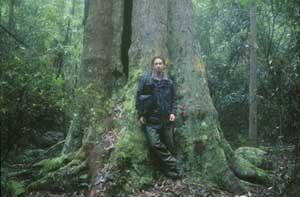
.
.
‘Fuel reduction burns threaten species’ – or Black Saturday incompetence an excuse for broadscale State Arson
[Source: Peter Vaughan, Monash University, Melbourne, 20100531,^http://www.reportage-enviro.com/2010/05/fuel-reduction-burns-threaten-endangered-species/]
.
‘Conservationists are concerned that fuel reduction burns in East Gippsland will threaten endangered species and reduce biodiversity.
On March 16, fire managers from the Department of Sustainability and Environment (DSE) ignited a fuel reduction burn in the Dinner Creek catchment of Waygara state forest, approximately 14 km West of Orbost. The fire quickly gained intensity, aided by a temperature of 30 degrees Celsius. It burnt most of the environmentally sensitive vegetation within the fire zone along four kilometres of the Dinner Creek.
DSE Fire Manager for the Orbost Region, Steve de Voogd, said that the Dinner Creek fuel reduction burn grew hotter than intended. The fire was meant to burn 2206 hectare of coastal forest and leave a mosaic of burnt and un-burnt areas within the fire’s containment lines.
.
According to Mr de Voogd, the DSE is now under community pressure to reduce the risk of wildfire through fuel reduction burning, and that must take precedent over ecological considerations.
.
“Although there is probably room for more fire ecology planning, it is incumbent on the DSE to take action because the consequences of doing nothing may be worse,” Mr de Voogd said.
Most of the hollow bearing trees in the burn zone, which were home to a number of endangered species protected under state and federal law, were destroyed.
Dr Rohan Bilney, an expert on Australian forest owls and spokesperson for the Gippsland Environment Group, said that the program intended to burn large areas of coastal forest without adequate ecological planning, monitoring or research, which threatened crucial habitat and food sources for the forest’s owls species.
.
“The coastal forests of East Gippsland are the strong hold of the Masked Owl, a species listed as threatened under two laws: the Victorian Flora and Fauna Guarantee Act and the Federal Environmental Protection and Biodiversity Conservation Act. Most of East Gippsland’s Masked Owls live in the coastal forests now being subjected to intense broad area fuel reduction burns by the DSE,” said Dr Bilney.
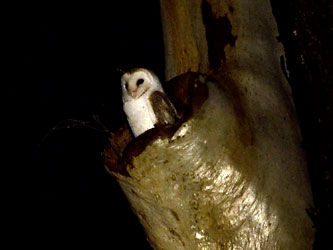
Masked Owl (Tyto novaehollandiae)
.
The Masked Owl Action Statement, prepared under the Victorian Flora and Fauna Guarantee Act, estimates only 150 pairs of Masked Owl exist in Victoria. Of that total, 100 pairs are found in East Gippsland and most are concentrated in the coastal forest.
DSE Manager of Biodiversity in East Gippsland, Dr Steve Henry, said that the current DSE fuel reduction fire strategy allows for large fires but burning on such a scale leaves few options for the protection of important ecological values.
“If there are some areas that contain specific environmental attributes that we want to protect, we could exclude them from fire with a bulldozer line. However that is expensive and often very destructive on most of these large burns. The main management technique used is the way in which the lighting pattern of the fire is done, sometimes that is not as effective as we would hope,” he said.
Mr Henry said that funding constraints have not permitted the DSE to conduct detailed ecological studies of the coastal forests, including the effect of fire on the environment.
A post-fire ecological survey is currently being conducted by the DSE in selected fuel reduction areas.
The Dinner Creek fire was just one of 48 fuel reduction burns planned by the DSE for the region during 2009-2010. Like other fuel reduction burns, the DSE must comply with the Victorian Code of Practice for Fire Management on Public Land.
The primary objective of the Code is to protect of life and property, while minimising negative impacts on natural and cultural values, and abiding by threatened species legislation, are also included.
The Code of Practice also states that the DSE must prepare a Fire Ecology Strategy that includes input from ecological experts and full consideration of all available scientific research.
If little ecological research exists, fuel reduction burning can be conducted under the rational that it may reduce the future risk of wildfire.
.
In the absence of scientific data, the DSE will continue to plan fuel reduction burns from computer desktops, utilising the ad hoc data collected as part of the Environmental Vegetation Class mapping projects of the late 1990s.
While political pressure continues to increase, the DSE fire policy will remain focused on protecting the community against the spectre of Black Saturday.’
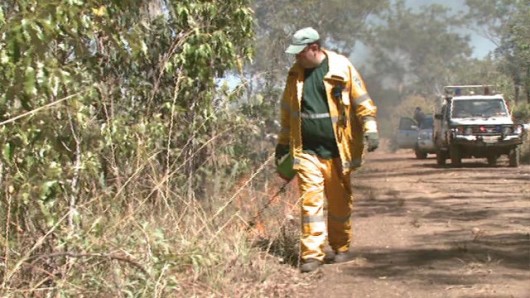 Burn it in case it burns, because we don’t have the resources for wildfire suppression Burn it in case it burns, because we don’t have the resources for wildfire suppression
.
.
‘Climate change, fires and logging -the deadly combination for Victoria’s species’
[Source: Environment East Gippsland, ^http://www.eastgippsland.net.au/?q=node/446]
.
‘Two hundred years ago the Sooty owl was abundant and fed on about 18 species of ground prey in Gippsland. Today they have only two or three to chose from. Other species are under similar pressure.
Many of our native animals have become sparser in numbers and their range has shrunk. Some, like the Southern Brown Bandicoot (Federally listed but not State listed), are now isolated in small “island” populations which are dangerously close to extinction mainly due to threats of fire and predation. Fires destroy understorey cover, making it easy for foxes and dogs to wipe out small populations of ground dwelling animals.
The 2003 fires and the recent December ’06 fires have destroyed the habitat and ground cover over about 2 million hectares of Victoria’s forested country. This has had a horrifying impact on ground mammals, birds and hollow dependent species.
.
Scientist and Quoll expert, Dr Chris Belcher, has calculated that this species’ Victorian numbers were reduced by 33 – 45% as a result of the ’03 fires. The December ’06 fires would have reduced this again to even more precarious numbers.
The isolated colony of Long Footed Potoroos discovered around Wonangatta (or Wongongara?) will most likely have been killed as a result of the recent fires.
The Helmeted Honeyeaters had five small and isolated populations left but the 1983 fires wiped out four of them. Yellingbo is still likely to burn and our faunal emblem will be extinct on this planet.
Bandicoots are very fire sensitive. There are small and vulnerable populations scattered in Gippsland. In 1994, fires burnt 97% of the Royal National Park and Bandicoots no longer survive in this area. The safety of thick ground cover does not return for years, meaning foxes and dogs heavily predate any survivors.
.
East Gippsland is the last stronghold for many of our rare and endangered fauna. It is a wetter environment and has much higher floristic diversity and therefore animals.
Climate change will now make fires more frequent and intense in SE Australia (CSIRO). Governments must adapt management of natural areas to account for this reality as it is for agriculture, water and energy.
The greatest pressure on Eastern Victorian species has been in the Critical Weight Range from 35 gms to 5 kg. Many ground dwelling animals are extremely susceptible to fire. Potoroos, Quolls, Bandicoots, native rodents (the rare New Holland Mouse, Smokey Mouse etc).
The predation rate after a fire is huge and patches of unburnt forest within the fire zones are absolutely essential to help populations survive predation, recover and disperse in time. These areas are critical to protect from further disturbance.
The recovery of species after a fire is now very different from 200 yrs ago. Populations are more isolated, salvage logging further destroys their chances, there is less diversity of prey species for the higher order predators like owls and quolls to turn to if gliders and possums are impacted by fires (or logging the hollow-rich forests).
Logging ecologically diverse forests favours the return of biologically poor tree communities such as silvertop and stringybark. The forests with mixed gum and box throughout can have 20-50 times higher animal densities. Significant vegetation changes due to massive landscape disturbance such as clearfelling, makes endangered species recovery from fire even more unlikely.
In the 1990s, East Gippsland supported seven times more threatened species than other areas in Victoria. This made the region seven times more important for our endangered species’ survival. Since the fires of 03 and 06, it is not unreasonable to suggest that East Gippsland is the last refuge and last chance for these species to survive extinction. Extinction can happen very quickly.
Species which are fairly general in their roosting, nesting and feeding needs can often survive (as they have in other areas of the state) but the many specialist species which rely on large areas of diverse and thick forest are highly likely to vanish forever.
This is why the hasty and unscientifically mapped areas of newly reserved forest require careful refinements. The needs of the state’s threatened species must be made the priority. Independent biologists and on-ground local knowledge (not VicForests) must be used to finalise the new reserve boundaries, with the long-term impact of the recent fires as a major guiding factor.
The Bracks Government suggested there be no net loss of resource as an adjunct to the mapped reserve areas. This is an impossible and irrational qualification as fires can take out large percent of the forest and therefore wood resources in one season. Commercial use of forest should be allocated only after biologically essential considerations have been adequately addressed.
Another point made in pre-election promises was to make sure the new areas are mapped and industry changes are resourced so as to adhere to the terms and spirit of the RFA. This then should see the government honour its long overdue commitment to carry out research into the impact of clearfelling on threatened species, to identify sustainability indicators, carry out five yearly reviews and ensure threatened species are protected. None have been honoured in the last 10 years!
The recent court ruling regarding the EPBC Act should also give the state government substantial opportunity to begin to alter protection measures for Federally listed species in East Gippsland.
The conscience of this government cannot put the very limited future of several sawmills ahead of a large number of entire species. Continued logging of intact original forests must not be the overriding priority. The ability for species to cope with the escalating impacts of climate change and fires from 2007 onwards has to now be put ahead of politics and union threats. These species survived well in Australia for over 40,000 years. The clearfell logging industry has been around for less than 40 years. Political priorities have an even shorter lifespan.’
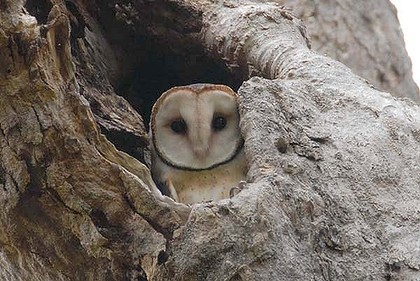
.
.
Further Reading:
.
[1] ^ http://eastgippsland.net.au/files/Sooty_Owl_%20Powerful_Owl_Bilney_December_2009.pdf , [ Read Report]
[2] Environment East Gippsland website, ^ http://www.eastgippsland.net.au/
[3] ‘ Sooty Owl Action Statement‘, Victorian Department of Sustainability and Environment (DSE), [ Read Statement]
[4] ‘ Powerful Owl Action Statement‘, (DSE) ^ http://www.dse.vic.gov.au/__data/assets/pdf_file/0019/103177/092_powerful_owl_1999.pdf , [ Read Statement]
[5] ‘ Masked Owl Action Statement‘, (DSE), ^ http://www.dse.vic.gov.au/__data/assets/pdf_file/0015/103173/124_Masked_Owl_2001.pdf , [Read Statement]
[6] Victorian Rainforest Network website, ^ http://www.vicrainforest.org/
[7] The Southern Peninsula Indigenous Flora & Fauna Association Inc., ^ http://www.spiffa.org/victorias-biodiversity-crisis.html
[8] ‘Protecting Victoria’s Powerful Owls’, ^ http://www.dse.vic.gov.au/__data/assets/pdf_file/0012/102144/PowerfulOwls.pdf , [ Read Report]
[9] ‘ Fire Protection Plan Gippsland Region‘, 2011, ^ http://www.dse.vic.gov.au/fire-and-other-emergencies/fire-management/fire-protection-plans/fire-protection-plan-gippsland-region , [ Read Plan]
[10] ‘ North East Victoria: Biodiversity‘, Australian Department of Agriculture, Fisheries and Forestry, ^http://www.daff.gov.au/__data/assets/pdf_file/0007/63583/Environmental_Values.pdf , [ Read Report]
[11] ‘ Submission to East Gippsland Forest Management Zone Amendments September 2010‘, ^ http://vnpa.org.au/admin/library/attachments/Submissions/EG%20Zoning%20Review%20Joint%20Submission%20ENGO%20Groups.pdf , [ Read Report]
[12] ‘ Ecology and conservation of owls‘ by Ian Newton, ^ http://www.publish.csiro.au/pid/3152.htm
.
Tags: DSE, Flora and Fauna Guarantee Act, fuel reduction program, habitat trees, hazard reduction, hollow trees, hollow-dependant fauna, Masked Owl, Powerful Owl, prescribed burning, Sooty Owl, State Arson, State Logging, VicForests, Victoria's old growth forests, Victorian Bushfires Royal Commission, Victorian Department of Sustainability and Environment
Posted in Gippsland (AU), Owls, Threats from Bushfire, Threats from Deforestation | No Comments »
Add this post to Del.icio.us - Digg
Wednesday, October 26th, 2011
It’s past time that the barbaric and backward chinese culture of Traditional Chinese Medicine (TCM) was recognised by the world’s civilized countries for what it is, an evil cult against wildlife, and so criminalised along with Female Genital Mutilation forthwith. Neither serve any purpose except barbaric harm.
TCM superstition claims that rhino horns cure typhoid fever, convulsions, cancer, rheumatism, gout, snakebites, hallucinations, headaches, carbuncles, vomiting, food poisoning, and ‘devil possession’. What backward quackery! Even the the rhino’s skin and faeces is used by TCM witchdoctors. Being superstitious and backward is one thing, but such ludicrously is driving and perpetuating the chinese illegal wildlife poaching of rhinos and elephants for their horns. Is this why the chinese regime is spreading its influential tentacles across Africa?
 Dried Tiger bone, Moon Bear bile, ground Elephant horn
All packaged and sold in an innocuous TCM grocer,
belying the world’s most barbaric cult against wildlife Dried Tiger bone, Moon Bear bile, ground Elephant horn
All packaged and sold in an innocuous TCM grocer,
belying the world’s most barbaric cult against wildlife
.
Today we learn that the last Javan rhino subspecies in Vietnam was found poached for its horn. It is now extinct.
The Javan rhino is Critically Endangered on the IUCN Red List of Threatened Species. In 2009 only ten individuals of the subspecies Rhinoceros sondaicus annamiticus remained in South Vietnam’s rainforest region.
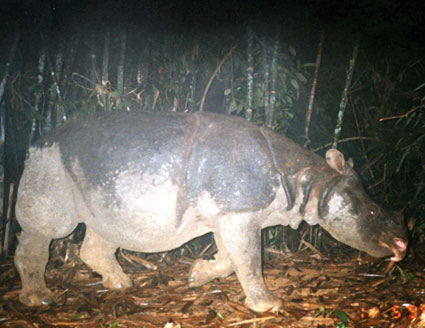 Javan one-horned Rhinoceros extinct as from yesterday due to poachers paid by the TCM witchdoctor cult Javan one-horned Rhinoceros extinct as from yesterday due to poachers paid by the TCM witchdoctor cult
.
‘Vietnam has lost its fight to save its rare Javan rhinoceros population after poachers apparently killed the country’s last animal for its horn, pushing one of the world’s most endangered species closer to extinction, a conservation group (World Wildlife Fund) said Tuesday (25th October 2011).
Vietnam’s Cat Tien National Park has had no sightings, footprints or dung from live rhinos since the last known animal living there was found dead last April, shot through the leg with its horn chopped off, the WWF said. Genetic analysis of rhino feces had confirmed in 2004 that at least two rhinos were living in the park, raising hopes that Vietnam’s population might survive.
Only 40 to 60 Javan rhinos now remain in Ujung Kulon National Park in Indonesia. They are the last known living members of the species, with none in captivity.
Vietnam’s Javan rhino population had been shrinking for decades as land conversion and a rising local population threatened the animal’s habitat, but poaching and a lack of effective park management and patrols hastened the decline, said Christy Williams, coordinator of WWF’s Asian Elephant and Rhino Program.
“It appears that protection is not being given a high priority by the Vietnamese government,” he said. Park director Tran Van Thanh said that while some of his rangers failed to fulfill their duties, it is impossible for them to stop all of the estimated 100,000 people living near the park from hunting exotic animals when the average farmer there earns around 150,000 dong ($7.50) per day.’
[Source: ‘Javan rhino goes extinct in Vietnam after last rhino poached‘, by Mike Ives, Associated Press, 20111026, ^http://www.csmonitor.com/World/Latest-News-Wires/2011/1026/Javan-rhino-goes-extinct-in-Vietnam-after-last-rhino-poached]
.
The subspecies Rhinoceros. sondicus inermis once found in Bengal, Assam, and Myanmar is now extinct. The subspecies Rhinoceros sondaicus sondaicus lives only in Ujung Kulon National Park, Java, and has less than 60 individuals remaining.

All these TCM potions and remedies contain a small amount of Rhinoceros horn
© Esmond Bradley Martin
.
The Yin and Yang philosophy may suggest a wholesome healthy balanced approach to alternative medicine, but according to the Australia Herbal Medicine Centre (a Chinese run practice in Sydney’s Chinese-centric Ryde)..”Chinese Herbal Medicines are mainly plant based, but some preparations include minerals or animal products.”
“Some of the conditions which may be treated by Chinese Herbal Medicine include:
- Chronic headaches
- Skin disorders
- Irritable bowel syndrome
- Constipation and diarrhoea
- Insomnia and fatigue
- Common cold and influenza
- Anxiety, depression and stress
- Allergies
- Rheumatoid and osteoarthritis
- Premenstrual syndrome and painful menstruation
- Excessive menstruation
- Infertility
- Impotence and prostate disorders
- Disorders associated with menopause
- Loss of appetite and common digestive disorders
- Fluid retention”
.
This all sounds impressive, but question is: Which remedies contain wildlife parts and so require illegal poaching? …sorry not on the label?
.
TCM is an evil backward cult inciting wildlife poaching and the key driver of wildlife extinctions around the globe. TCM ethically needs to be immediately banned, its barbaric practices made illegal and its products containing animal parts declared illegal wildlife trafficking and so an illegal import. Poaching endangered animals is far worse than mass slaughter of non-endangered animals or even the mass slaughter of humans. Species Extinction is the worst crime on the planet, because a whole species is threatened with extinction, not just a few million humans or so out of 7 billion.
.
The Sydney Institute of Traditional Chinese Medicine [http://www.sitcm.edu.au/] needs to immediately and publicly renounce any use of wild animal parts in its practice, else be immediately criminalised as an ecologically destructive cult.
Rhino Horn is not medicine – chew your nails instead. Go and see a real doctor!
.
.
.
Further Reading:
.
[1] ^ http://www.csmonitor.com/World/Latest-News-Wires/2011/1026/Javan-rhino-goes-extinct-in-Vietnam-after-last-rhino-poached
[2] ^ http://newswatch.nationalgeographic.com/2009/11/23/dogs_sniff_out_rhinos_of_vietanm/
[3] ^ http://www.asianscientist.com/topnews/wwf-traditional-chinese-medicine-rhino-horn-cancer-cure-cites-meeting/
[4] ^ http://www.guardian.co.uk/environment/video/2011/oct/25/javan-rhino-extinct-vietnam-wwf-video?newsfeed=true
[5] ^ http://www.rhinoconservation.org/2010/01/15/is-surge-in-illegal-rhino-horn-trade-linked-to-chinas-designation-of-tcm-as-strategic-industry/
[6] ^ http://www.treehugger.com/files/2011/01/does-protecting-endangered-rhinos-conflict-with-traditional-chinese-medicine.php
[7] ^ http://www.greenfudge.org/2011/08/22/tcm-quackery-fuels-brutal-rhino-poaching/
[8] ^ http://www.sciencebasedmedicine.org/index.php/asian-bear-bile-remedies-barbarism-or-medicine/
[9] ^ http://www.abc.net.au/news/2010-02-06/female-circumcision-happening-in-australia/2594496
.
Tags: Australia Herbal Medicine Centre, backward chinese, evil cult, Female Genital Mutilation, illegal wildlife trade, Javan Rhino subspecies extinct, rhino poaching, Rhinoceros sondaicus annamiticus, Sydney Institute of Traditional Chinese Medicine, TCM, TCM witchdoctor cult, Traditional Chinese Medicine, Tran Van Thanh, Ujung Kulon National Park, Vietnam Rhino extinct, wildlife extinction, world's most barbaric cult, WWF's Asian Elephant and Rhino Program
Posted in Africa, Rhinoceroses, Threats from Poaching and Poisoning | No Comments »
Add this post to Del.icio.us - Digg
Wednesday, October 26th, 2011
This article was initially published by Tigerquoll 20090514 on CanDoBetter.net:
.
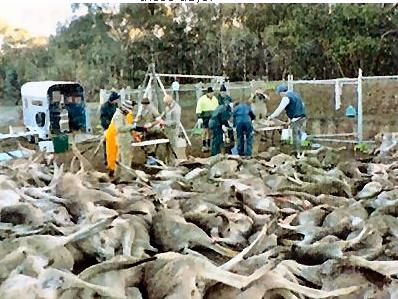
.
Australia’s Defence Minister, Joel Fitzgibbon MP, has just been handed AUD$26,950,000,000 to unjustifiably escalate Australia’s military aggression, at a time when Federal Treasurer Wayne Swan says the world economy is gripped by the worst recession in 50 years.
Labor’s 2009 Defence White Paper indulges to the extreme, planning for so-called “Defence” (against what?) to receive some $146 billion in additional funding across the life of the White Paper to 2030.
Hypocritically at the same time, Fitzgibbon has rejected spending just $3.5 million to save thousands of Australia’s grey kangaroos fenced in on Defence land at Majura training range just outside Canberra. And at a time when Federal MPs have just awarded themselves another pay rise of $4000 pa for ‘electoral allowances’. It all stinks like British Parliamentary abuses.
Australia’s kangaroos, stressed from people altering their habitat, have been denied their freedom to roam their traditional grazing lands due to it being bulldozed for selfish property development, due to drought, consistent shooting and from uncontrolled bushfires.
Despite wildlife ecologist Dr Dror Ben-Ami telling the review tribunal that the Defence Department has no assessments of any impacts caused by the kangaroos nor that the kangaroos pose any threat to any threatened species on the Majura range, Fitzgibbon has condoned the senseless slaughter of 4000 of a population of 9000 trapped kangaroos be shot in secret, just last Saturday, 9th May 2009. Fitzgibbon approved a similar massacre just on a year ago at the same place – it must be some idea of a sick sport to him!
Fitzgibbon says it is to reduce the kangaroos to ‘sustainable levels‘.
How’s the language?
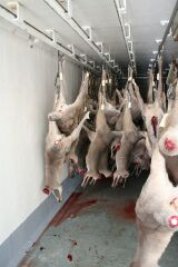 How is this mass killing different to April 1994 when the Hutu militia hacked thousands of Tutsis to death in Rwanda, or July 1995 in Srebrenica when Serb General Ratko Mladic systematically selected and then massacred 8,372 men and boys ‘of fighting age’ (between the ages of twelve and sixty), or in May 2000 when the Sri Lanka Army used banned cluster bombs from China, multi barrel rocket Launchers killing 2,000 Tamil civilians in the island’s north? How is this mass killing different to April 1994 when the Hutu militia hacked thousands of Tutsis to death in Rwanda, or July 1995 in Srebrenica when Serb General Ratko Mladic systematically selected and then massacred 8,372 men and boys ‘of fighting age’ (between the ages of twelve and sixty), or in May 2000 when the Sri Lanka Army used banned cluster bombs from China, multi barrel rocket Launchers killing 2,000 Tamil civilians in the island’s north?
Just four days ago, 378 Tamil civilians were killed after Sri Lankan forces fired a massive barrage of artillery shells at Tamil Tiger rebels. Again the UN stands by – bit like how Pope Pius XII stood back while Hilter’s Nazis massacred millions of Jews during WWII.
In these human massacres, the killers use propaganda to describe their victims such as ‘terrorists’, ‘militants’ and justfity the massacres as ‘ethnic cleansing’. In each of the above human massacres, the UN has stood back and watched.
Like these human massacre, thousands of Australia’s iconic kangaroos, have just as much right to life as humans, yet they are been similarly slaughtered in secret. Defence uses fabricated propaganda like the kangaroos being in “plague proportions” and “hordes” and “pests”, that their “populations have exploded”; that they “compete for pasture”; and the latest ludicrous example; “they are eating endangered species of grass”. All so as to spin the sick aim of “sustainable culling”.
It’s simply a ecological massacre. It has just been done in secret with approval of Joel Fitzgibbon.  How is he any different to Sri Lankan Defence Secretary Gotabhaya Rajapaksa? How is he any different to Sri Lankan Defence Secretary Gotabhaya Rajapaksa?
This tragic massacre deserves to be written into Australia’s history as……’Fitzgibbon’s Massacre‘.
.
.
.
Further Reading:
.
[1] ‘ Roo cull eases pressure on reserves‘, by Margaret Burin, ABC Local, 20110628, ^ http://www.abc.net.au/news/stories/2011/06/28/3255317.htm?site=canberra
‘Nearly 2,500 kangaroos were killed during the three week cull in Canberra’s nature reserves….’
.
[2] ‘ Kangaroo Shooting: the largest land-based commercial wildlife slaughter in the world‘, by Animals Australia, ^ http://www.animalsaustralia.org/issues/kangaroo_shooting.php
‘Each night in remote areas of the Australian outback thousands of kangaroos graze peacefully, stand up on hearing an approaching vehicle, stare into a blinding spotlight, and are shot for their meat and skins.
The commercial kangaroo kill ‘quota’ for 2009 (the number permitted to be killed) is just under 4 million kangaroos….’
.
[3] ‘ New Report Exposes the Grubby Reality of the Kangaroo Industry‘, by Animals Australia, ^ http://www.animalsaustralia.org/issues/kangaroo_shooting.php
‘A new report ‘A Shot in the Dark – a report on kangaroo harvesting’, commissioned by Animal Liberation (NSW) was released in May 2009
outlines problems of hygiene in the kangaroo meat industry, sustainability of kangaroo populations and animal welfare. The report estimates some ‘440,000 dependent young kangaroos are either clubbed to
death or left to starve after their mothers are killed’. Read Report: ^http://www.kangaroo-protection-coalition.com/shotinthedark.html
.
[4] ‘ Australia officials want to kill 3,000 kangaroos‘, by Rob Griffith, Associated Press, 20070514,^ http://www.msnbc.msn.com/id/18656748/ns/world_news-
asia_pacific/t/australia-officials-want-kill-kangaroos/#.Tqb-pbKLNhU
‘CANBERRA, Australia — Authorities said Monday they want to shoot more than 3,000 kangaroos on the fringes of Australia’s capital, noting the animals were growing in population and eating through the grassy habitats of endangered species.’
A cull of about 800 kangaroos in the Canberra area in 2004 also brought a large outcry from animal activists. In 2003, authorities ordered the killing of 6,500 eastern grays at the Puckapunyal military base, 62 miles north of Melbourne. A year earlier,
a similar shooting operation killed more than 20,000 kangaroos on the base.’
.
[5] ‘The life and death of Kangaroos‘, by Ray Drew May 2008, ^http://www.kangaroolives.com/inhumanity.htm
‘On Monday May 19, 2008, government contractors started killing the kangaroos on a former naval base in Canberra, Australia. By May 29 they (514) were dead. This, in a diary in reverse, is their story and the fight to save them. ALL OF THE KANGAROOS IN THE PHOTOGRAPH ABOVE ARE NOW DEAD. THEY WERE NEEDLESSLY KILLED IN THE LAST WEEK OF MAY 2008, following a world wide campaign to save them….’
.
Tags: Australia's grey kangaroos, Canberra, Defence Department, Fitzgibbon Massacre, Joel Fitzgibbon, kangaroo cull ACT, kangaroo slaughter, kangaroos shot Canberra, Majura Training Area, roo shooter
Posted in Kangaroos and Macropods, Threats from Poaching and Poisoning | No Comments »
Add this post to Del.icio.us - Digg
|
|
 An infamous licensed shooter
An infamous licensed shooter
 Publisher: ^http://www.panmacmillan.com.au/
Publisher: ^http://www.panmacmillan.com.au/
 Kangaroo survives arrow shot through head
Kangaroo survives arrow shot through head




































































